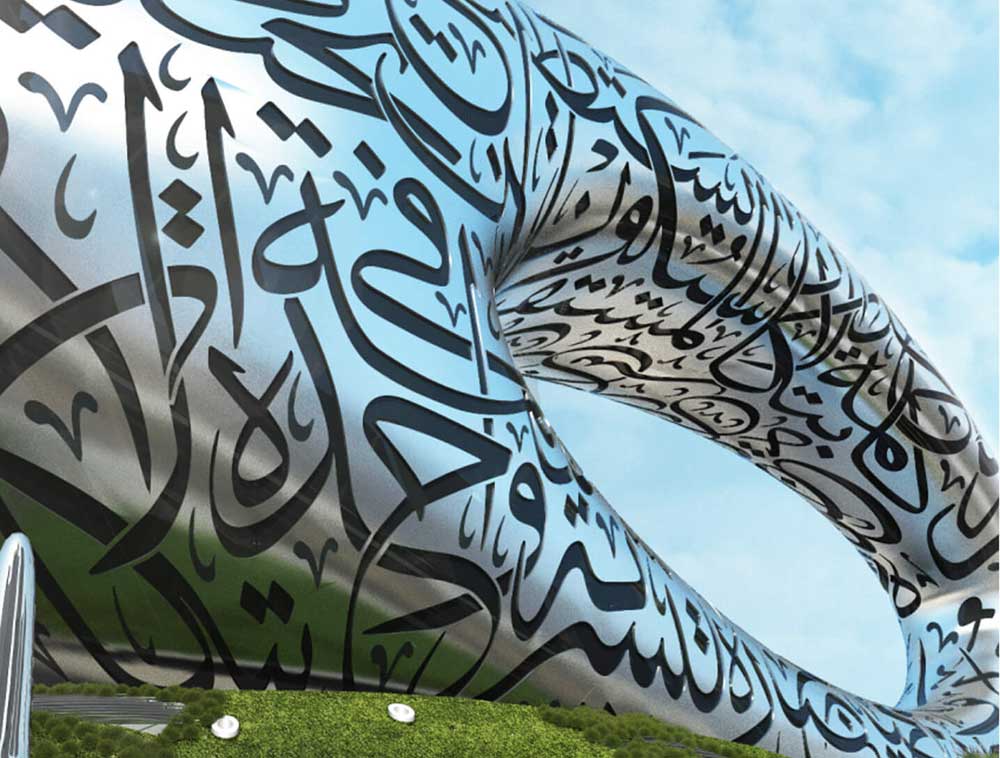Dubai - The Architecture
last update: 09 May 2020
Our New Year trip for 2020 ran from late January 2020 to mid-March 2020 and involved 8 nights in Dubai and 43 nights in Phuket. We spent 3 nights in Dubai outward bounds, and 5 nights in Dubai on our return flight.
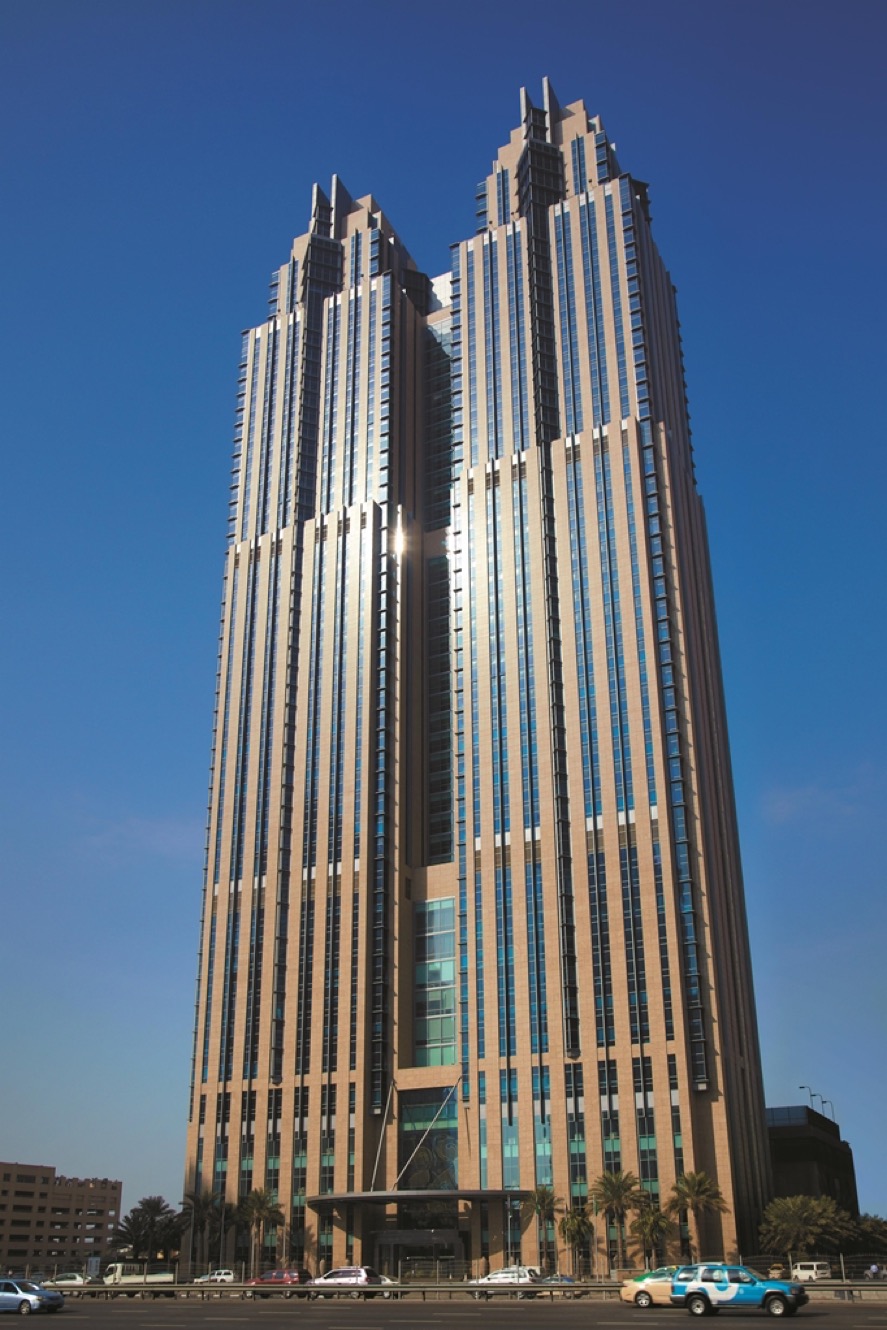
Our first hotel was the 196 metres tall twin-tower 5-star Shangri-La Hotel in 'Downtown Dubai' (check out our hotel review).
Driving from the airport to Downtown Dubai one is inevitably impressed by the number of modern looking skyscrapers. One of the first things we did at our hotel was visit the exterior terrace on the 42nd floor, which was famous for its view over Dubai city (check out the video).
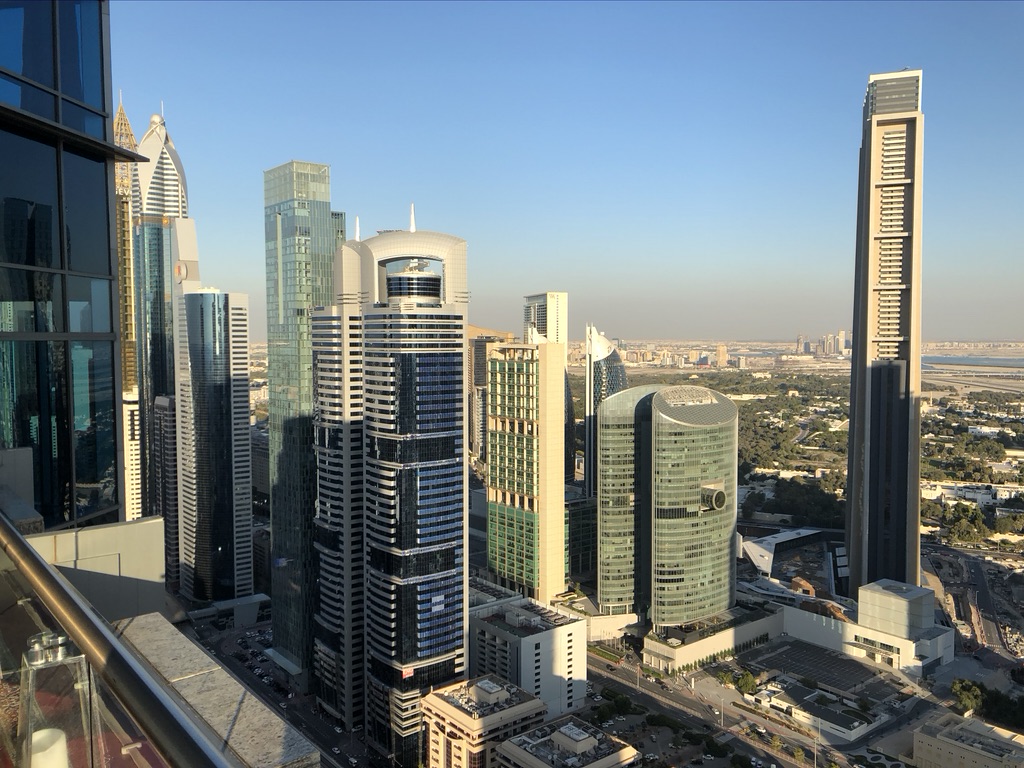
We can see on the very far left just a little bit of the 75-storey (358-metres), 528 room, 4-star Gevora Hotel (completed 2017). It is in part obscured by the 333 metres, 684 room Rose Tower hotel (completed 2007). Then we can see the 269-metres residential 21st Century Tower (completed 2003). Continuing along the main street we have the very rectangular looking 235-metres, mixed-use Rolex Tower (completed 2010), and nearest to us we the twin towers of the 250-metres Angsana Hotel & Suites (completed 2008), although they are no longer managed by Angsana Hotels & Resorts.
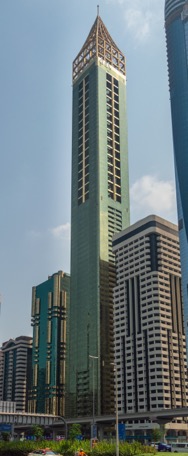
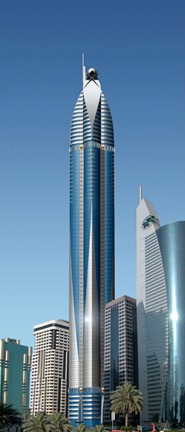
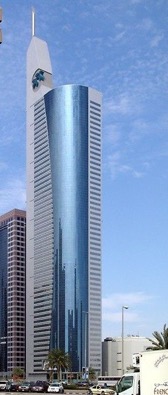
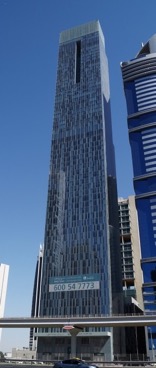
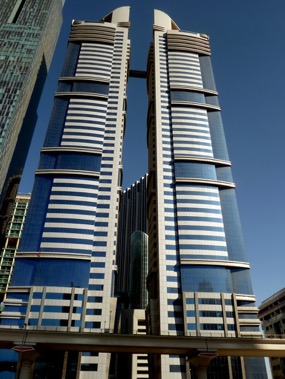
With 358 metres the Gevora Hotel tower is said to be the worlds tallest hotel (checkout this video and this video), and I understand that they also offer special day passes to their sky-high pool. However, the new 360-metre tall Ciel Hotel tower in the Dubai Marina area will open in early 2023.

The Rose Tower (above) hotel was the tallest hotel in the world 2009-2012, before being replaced by the Gevora Hotel tower next door. The original design was for a 380-metre tower, but in a design modification it was reduced. The spire was designed around the idea of a rosebud. The Rose Tower is also an alcohol-free hotel.

The 21st Century Tower (above) sits on an awkward rectangular plot with a corner cut away on one side, so the architects designed the tower as two intersection structures, back and front, and tried to exploit the chafed corner into the overall design. The design consists of winged feathered elements inspired by doves in flight.

The architects of the Rolex Tower (above) tried to capture the design elegance of the Rolex watch, and build a 'shimmering desert mirage'. They wanted to extend the glass façade to the very tip, and cap the building with a clear glass beacon.
More generally, this video presents the way the foundations are built for the different skyscrapers mentioned above.
Set back from the main street, we can see the 135-metres, office-retail, twin Emirates Financial Towers (completed 2011). And we can also see the 326-metres, tall-thin looking, mixed-use tower The Index (completed 2011).
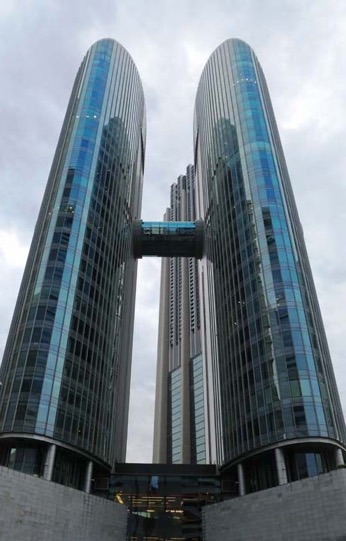
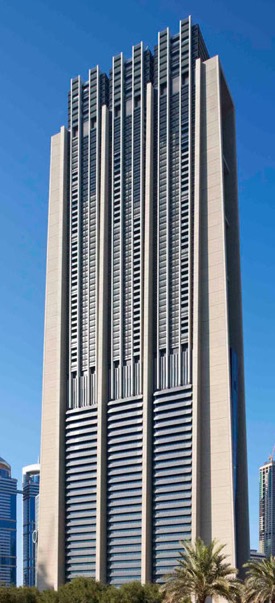
The Emirates Financial Towers has at least two distinctive features, firstly the skybridge between the two buildings, and secondly the worlds largest automated parking system with 1,191 spaces.
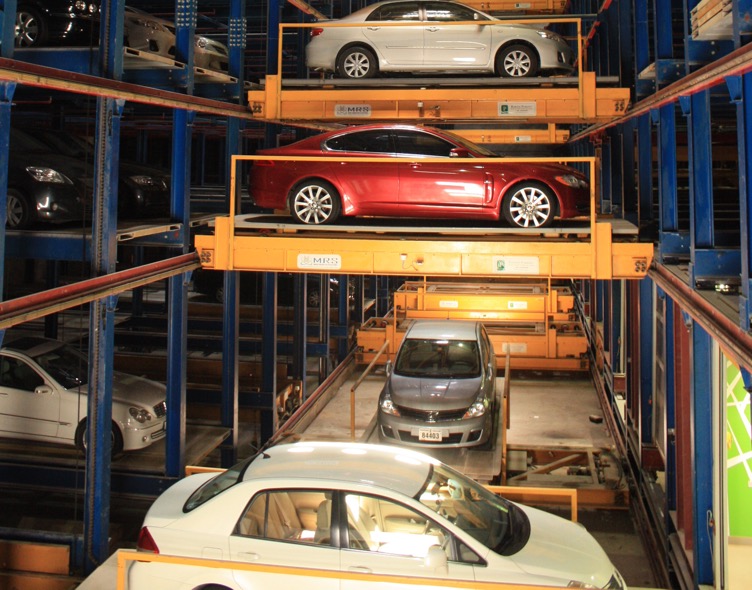
It is said that The Index tower (see video), was one of the first to be built to minimise its environmental impact. The compact design reduces the need for mechanical cooling systems and artificial lighting. Its orientation maximises the views and reduced solar gain. The buildings mass is designed to absorb heat and limit the need for mechanical ventilation, and sunshades shelter the interiors on the exposed south façade.
Below we can see the Burj Khalifa in the background (see our separate webpage on this skyscraper).
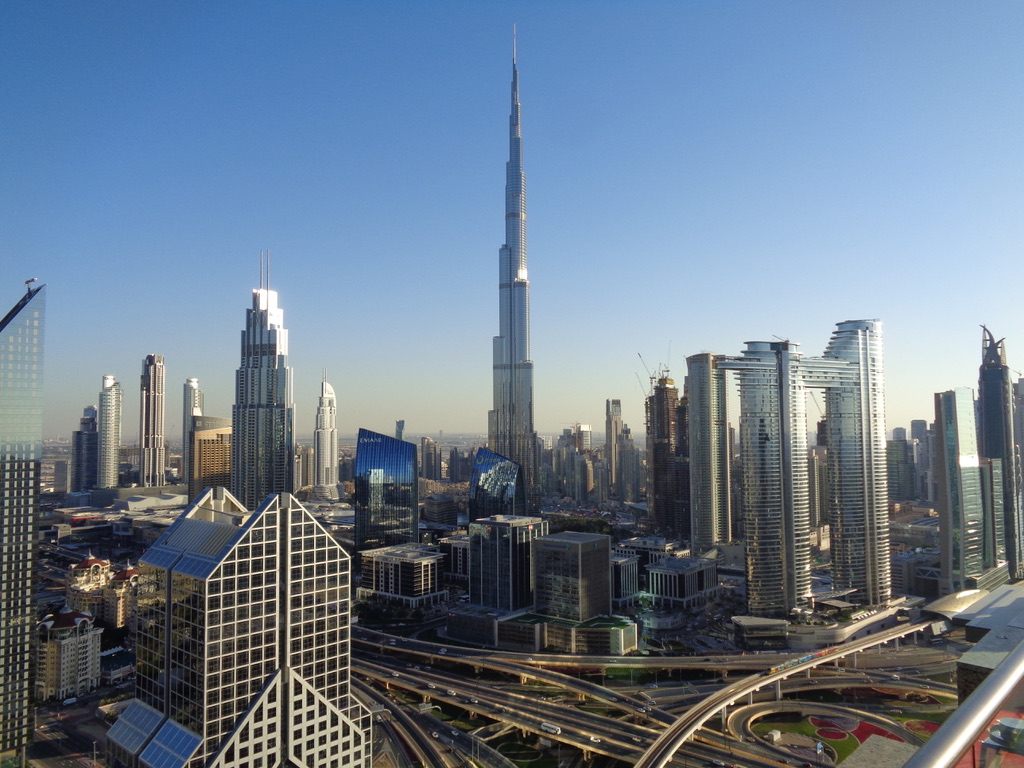
In the foreground we have the 153-metres, Hotel Dusit Dubai (completed 2001). And in the right foreground we have the 261-metres, hotel-residence called The Address Residence Sky View (completed 2018). This is a video of the lifting of the skybridge in 2017, and here is a tour of the building.
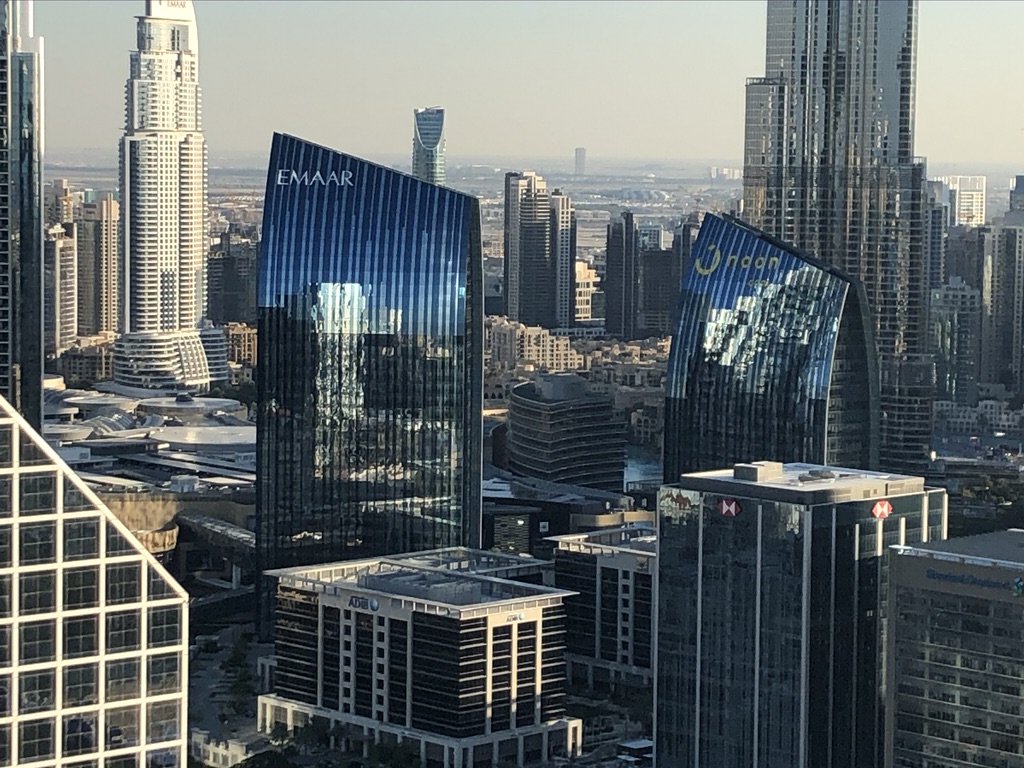
If we zoom-in a bit we can see the twin towers of Boulevard Plaza. Boulevard Plaza 1 is 168-metres tall, and was completed in 2007, whereas Boulevard Plaza 2 is 141-metres tall, and was completed in 2010. The large white building in the background on the left is the 302-metres, hotel/residential Address Downtown (completed in 2008). The Wikipedia article on the Address Downtown gives a good account of the fire that occurred in 2015 on the 20th floor.
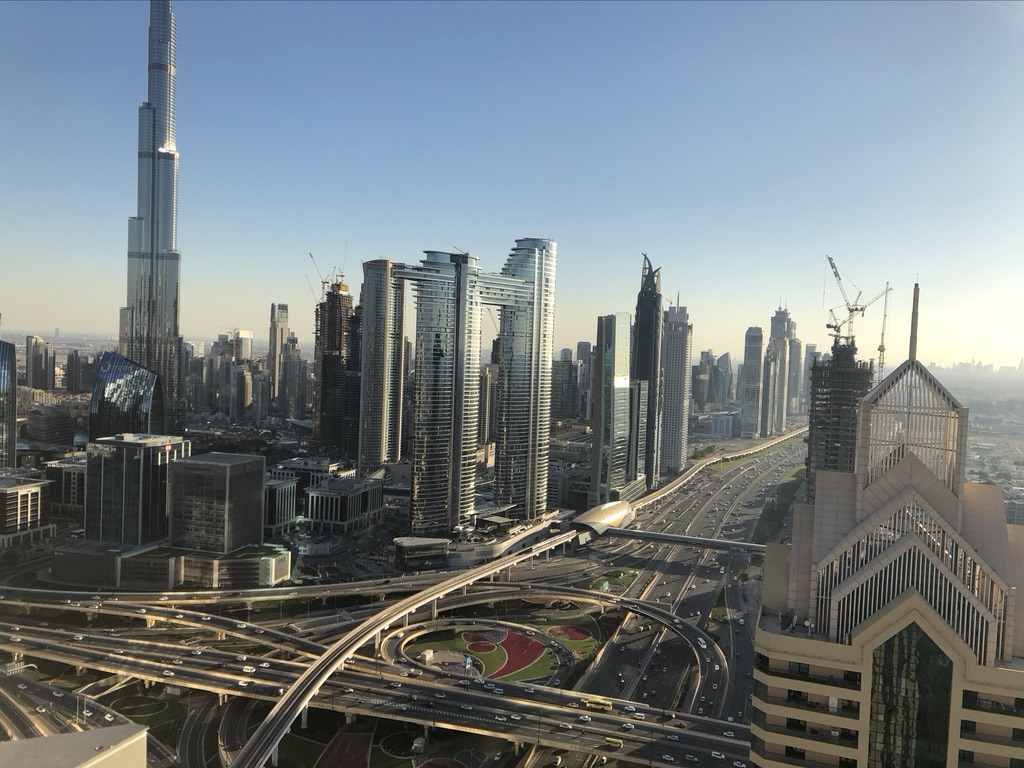
Above, in the foreground on the right we have the Al Manara Tower (completed 2004), which was named after the location Al Manara. We can see numerous towers going off into the sunset, but it's worth mentioning the Al Hekma Tower (completed 2015), with the very elaborate spire.

There are some reports that the spire should project an image of the Sheikh Issa Bin Zayed Al Nahyan.
Building in the United Arab Emirates
The United Arab Emirates (UAE) consists of seven emirates and has an area of around 83 thousand kilometres (so about twice the size of Switzerland). The landscape consists of a few mountains in the north-east, desert, and a costal area. Until oil was discovered, portable water determined where people could and could not live.
The UAE controls the fifth largest proven oil reserves in the world, but Abu Dhabi has 94% of those reserves. After the discovery of oil in 1958 the local economy started to shift to a service economy based upon tourism, coupled with a dramatically increased reliance on imported labour. The population in the UAE started to move to the costal cities, e.g. Abu Dhabi, Dubai and Sharjah. This lead to a sudden urbanisation of costal towns, and the infrastructure rapidly proved inadequate. Existing buildings were replaced with new buildings, many of them also taking on a symbolic role. The wealthy built new homes in new areas, leaving the older areas for the poorer indigenous population and foreign labour.
The Emirati poet Hamad Bu Shihab wrote,
Yesterday these were disunited Emirates
Suffering ignorance, poverty, illness, and chronic disease
And today the Lord had bestowed upon us his grace
In unaccountable abundance
The challenge today is to decide how best to use this 'unaccountable abundance'. Is Dubai just a playground for the world's affluent, financed by borrowed money and built by the planet's very poor? Is Dubai doomed because of real estate excesses, rampant greed, easy credit, predatory lending, and a global imbalance in trade and finance? Dubai's oil resources are only slightly more than those of the United Kingdom, so they will not last forever. Already today Dubai is changing and it service economy already represents 75% of GDP. So how should Dubai invest in its future?
Why is architecture so important to Dubai?
The answer is in fact not as easy as you think. Why do we have architecture, as opposed to just mundane buildings? Architecture in this sense is about imagining and testing out a future, or different futures. Tourism and architecture have been linked for some considerable time. As early as 1500 BC travellers would go to see the Egyptian pyramids. During the Roman Republic, spas and costal resorts were popular among the rich. The tradition of pilgrimage exists in many religions. Already in the 10th C there were secular travel writers who would describe and critique what they saw. In the 17th C the Grand Tour gave the wealthy the opportunity to study classical antiquity and the Renaissance. With the arrival of rail and the steamboat, the 'Cook's Tour' became a byword. By the 1890's we had mass tourism, and today we have niche tourism with everything from cultural tourism to medical tourism, and more recently sustainable tourism.
Modern tourism, good or bad, is now defined by the tourist resort, a single place where everything is provided (hotels, entertainment, shopping, etc.). In many ways Dubai has gone that one step further, fusing housing and holiday accommodation into one undifferentiated landscape. For example, Dubai has a natural beachfront of about 75 kilometres, but with artificial islands they want to add another 1,500 kilometres of coastline. Dubai in many ways is the model for the future tourist resort. You get off the aeroplane next to the hotel (streets and walking are abolished). The weather is always hot, and the principle activity is shopping in massive, seductive, air-conditioned shopping 'experiences'. The city expands and evolves to meet demand. If something is no longer popular, knock it down and build something new. Culture is pre-packaged in museums and in sanitised 'historic' areas (it may look old but it was built last week). There is a risk that the 'thrill' disappears, but daring architecture and innovative urban planning can 'save the day'. Dubai thrives on newness (and bigness), so new and big architecture is absolutely vital.
As one author put it "Dubai is accelerating the present and fashioning the past" to ensure its future in a global tourism market. Dubai has exponentially increased the scale of its urban projects, with an emphasis on the iconic to attract media attention and foreign investment. Speed generates confidence, inspires continued investment, and promises profit. Modern buildings shows that you are part of the modern world. Increasing land value was the incentive to build upwards, and importing new building materials and techniques made it possible. The emerging skyline became a symbol of progress and prosperity. What we see today is that each building is competing for attention, each must be more visually arresting and ever more iconic. The Burj al-Arab hotel and more recently the Burj Khalifa are perfect examples.
The population of Dubai was 60,000 in 1969, and today it's over 1 million. Today Dubai is visited by more than 15 million tourist annually, staying in more than 400 hotels. Is Dubai a version of Las Vegas (minus the vices) or Disneyland (plus the beach), or a mix of both?

The venerable Dubai World Trade Centre was the first skyscraper built in Dubai (check out the video "The Untold Story of Dubai's First Skyscraper" and the article "How Dubai's World Trade Centre Sold the City to the World"). The 39-floor tower, originally known as the Sheikh Rashid Tower, when completed in 1979 was the tallest building between Mumbai and Athens. The blue-green coloured building next to it is the World Trade Centre Residence, a 41-floor, 5-star residential tower finished in 2008.

There are lots of ways to view this type of building. Today it has become increasingly important to view buildings in terms of their economic and environmental sustainability. For example, even in 1979 the energy consumption of the Dubai World Trade Centre was 6 times higher than for an equivalent building in Europe. In Dubai a buildings' air-conditioning accounts for 60% of its energy consumption. The proper use of daylight can reduce energy consumption for artificial lighting and for cooling, because natural lighting generates less heat than electric lighting. The Dubai World Trade Centre is square with façades facing northeast, southeast, southwest, and northwest. Building in hot humid climates should not give equal importance to all façades. The service cores are inside the building, whereas they can become solar buffers when placed on the exterior of a tower. One good point is that shading devices are used to protect windows from overheating.
Today (2020) there are 108 skyscrapers in Dubai that are taller than 180 metres (the poor old Dubai World Trade Centre is only 158 metres tall).
If architecture is about testing what people might want in the future, then it must be linked with ideas about nationhood, history, and cultural identity. Certainly in the 20th C, Western architecture involved a lot of experimentation in both building practices, materials and aesthetics. According to some experts, modern architecture in the Middle East was initially equated with Westernisation. They would ignore historical precedent in order to create something new and progressive, and which supported an economic or nationalist agenda. In Dubai architecture exemplifies development, and the approach to commercial, shopping and hotel buildings has resulted in a 'Dubai Effect'. Part of that effect is the ability to go skiing in the desert or stay in an underwater hotel room, but also part of the effect is that visitors to the Dubai leave "wondering why their governments can't issue passports in a day or provide clean mosques and schools, better airports, airlines and roads, and above all, better government".
When people think of Dubai they think of the tallest building in the world and the largest encloses mall in the world (I have separate webpages on the Burj Khalifa and The Mall). If people look beyond these two mega-buildings they almost always see the Dubai World Trade Centre mentioned as the 'first' important building in Dubai. But Emirati society attributes great importance to its history, culture and religion. For example, if you look carefully you will see the urban landscape dotted with the domes and minarets of local mosques often privately financed with government subsidies.
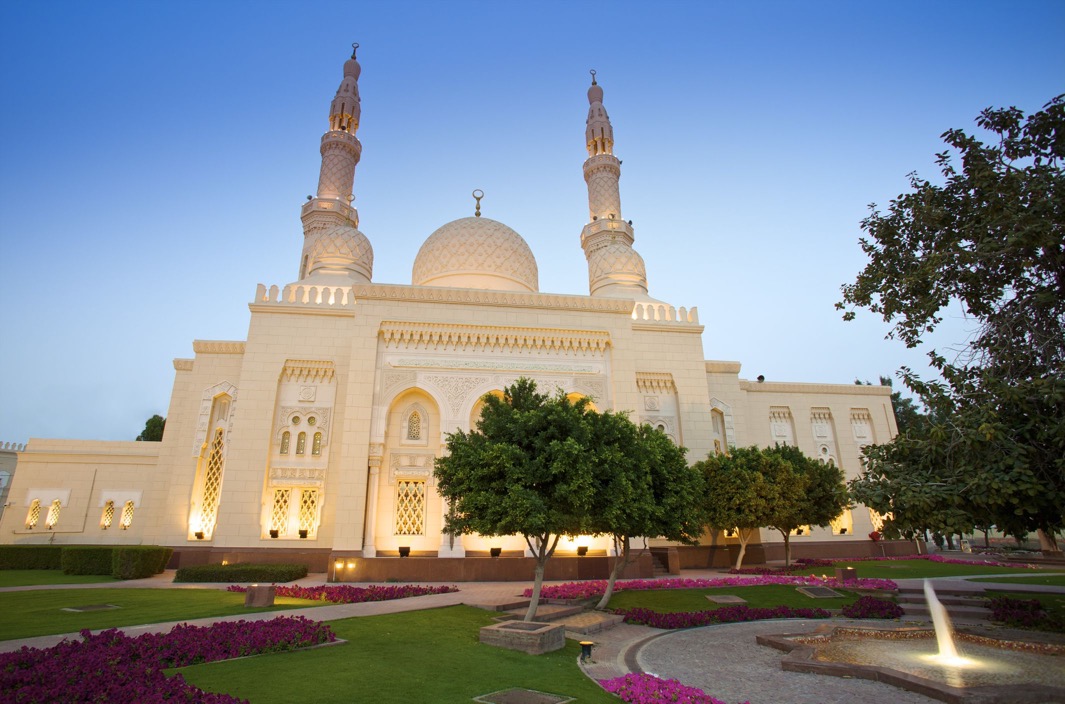
In the same year the Dubai World Trade Centre was finished (1979), the Jumeirah Mosque was also opened, This mosque is often called the 'Great' Mosque, which is different from the Dubai Grand Mosque. The inspiration was Mamluk architecture, most visible in medieval Cairo. It's interesting to note that the late Rashid bin Saeed Al Maktoum (1912-1990) was the patron of both mosques. Because Mamluk architecture was always the product of individual investment, we can asked what Sultan Rashid wanted to tell us. Clearly with both buildings he wanted to push for the modernisation of Dubai. The motivation for the Dubai World Trade Centre is obvious, but also the original Mamluk sultans saw architectural complexes as charitable legacies. It is quite probable that the Sultan Rashid also sought affiliation with older cultural and architectural formats. The stylistic connection with Cairo is deliberate in that an Egyptian company was the builder. The Jumeirah Mosque can be visited as part of the 'Open doors. Open minds' initiative.
I've read many texts that refer to the Jumeirah Mosque as being built in the Fatimid style. This style is said to derive from the Ismaili Shia that took Cairo as its capital from 969-1171. These texts suggest that the architectural style is not discussed much since the UAE is predominantly Sunni Islam. On the other hand I've also read that the architectural style is really a mix, but with Mamluk architecture being dominant. Wikipedia highlights that the Mamluk Sultanate (1250-1517) was converted to Sunni Islam and strongly believed in the symbolic role of the mosque and mausoleum. Others have noted that the Mamluk dynasty holds great meaning for the modern rulers in the Gulf, who associate themselves with those who conquered Egypt, Syria and the Hijaz between the 13th C and 16th C.
The Dubai World Trade Centre is featured on the Dh100 note, and the Jumeirah Mosque (also known as the 'two minaret mosque') is featured on the Dh500 note.
Every country looks to manage its historical narrative, and the United Arab Emirates (UAE) is no different. In Europe the museum was see as a way to display both national treasures and the spoils of conquest. In some other countries the national museum was seen as a way to help people learn about their ancient past through archaeological discoveries made in the 19th C. Coupled with the recognition of traditional arts, they helped unify the culture of newly formed nations. The museum has been called the 'inventor of tradition', and along with universities have been so useful as prime institutional buildings commemorating statehood.
In the UAE museums look to extol the regions ancient history, and ignore the role of the Ottoman Empire in the region. Archaeological finds are juxtaposed against timeless images of dhows and camels supporting the idea of a national identity and an indigenous past. The al-Fahidi Fort, constructed in 1787 near Dubai Creek, was designated a national monument in 1971 and transformed into the Dubai Museum.
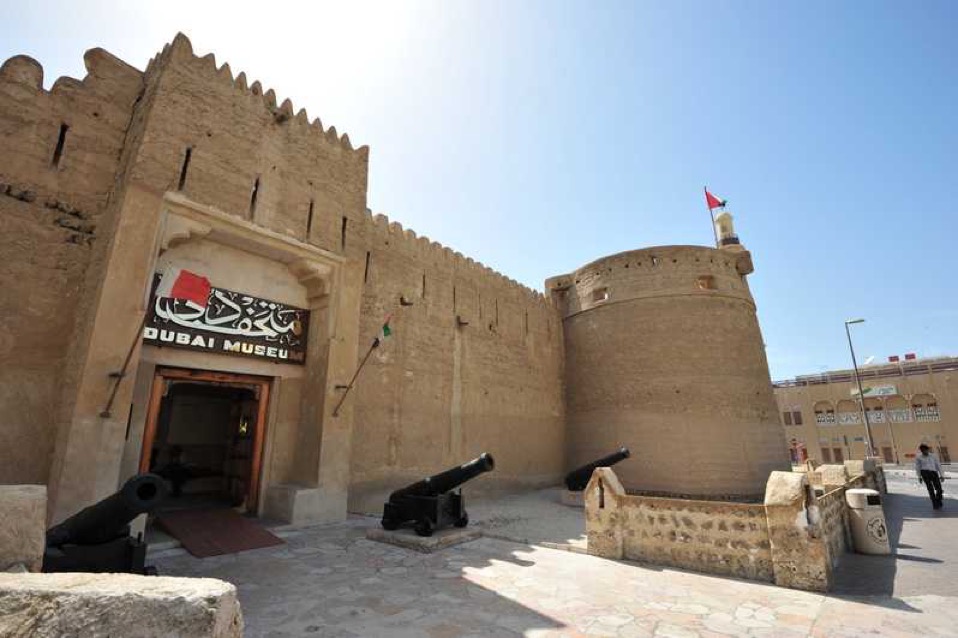
Just as a reminder, below we have an old photograph of Dubai Creek, but from when does it date?
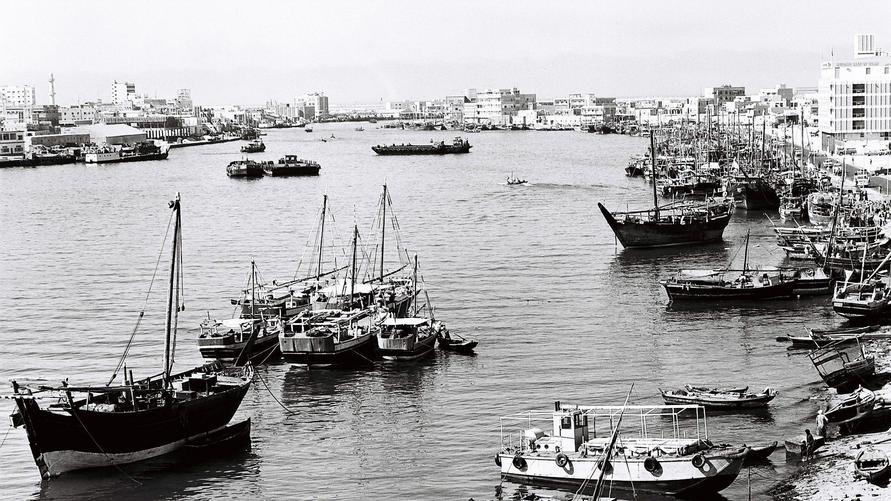
The photograph was taken in the late 1960's, and the first bridge crossing this creek was built in 1963. Dubai had been a transit point for caravans on the trade route from Iraq to Oman, and for dhows between Indian, East Africa and the northern Gulf. The transition from a collection of mud huts (still visible in 1922), through a trading hub in the 1870's, and now to the skyscraper capital of the world, is a modern miracle. Dubai is the perfect example of a post-oil, post-modern, 'instant city' and international tourist destination.
Through the 20th C Dubai had attracted a variety of immigrants, from pearl divers to migrants from Iraq and Pakistan. In the 1970's Dubai became an important business centre in the Gulf, and a very rare tax free marketplace. However, possibly the most important decision was, in 2002, to allow foreigners to buy homes. Let's be perfectly honest, Dubai is situated in one of the world's most barren places, and it had no important historical sites worth visiting. Yet today people will fly halfway around the world to holiday there.
The Dubai World Trade Centre was built after oil was discovered in 1966, and immediately a number of banks started to build along Dubai Creek, the historical trading and marketplace of the city. Perhaps the Emirates National Bank of Dubai (NBD) symbolises Dubai's modern commercial character more than any other building. The building was designed by Carlos Ott and was completed in 1997. The NBD is on the left and the Dubai Chamber of Commerce and Industry is on the right.

The architect claims that the building was inspired by the traditional dhow, a sailing vessel used in the Red Sea and the Indian Ocean. It has been said that traditionally an architect would look for inspiration in the local monumental architecture of the past. However, in Dubai the architects were forced to look beyond history, and they used the idea of waves and sails for inspiration. In this particular building the architect has pushed the reference to a dhow to the extreme. The clean lines and lack of ornamentation is often referred to as the 'international style'. Some experts have suggested that this building has 'dignity', something a national bank should have.
With the Emirates National Bank of Dubai we can see that Dubai had resolutely accepted the 20th American corporate skyscraper. So our next example is a perfect example of a building inspired by the landmark Chrysler Building in New York (below).
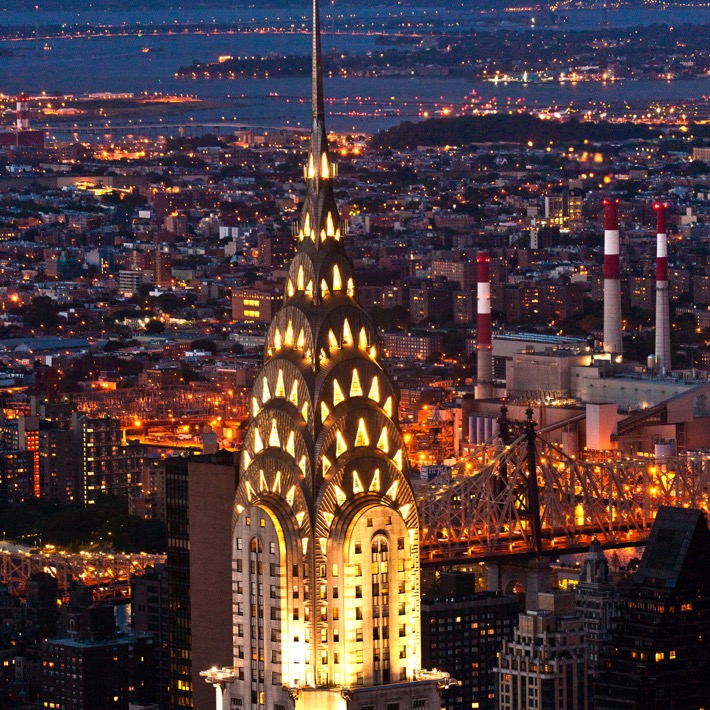
The al Kazim Towers are situated in Sheikh Zayed Road and they have the same cascading sunburst pattern on their roofs. These towers were completed in 2008 at a cost of AED 630 million.

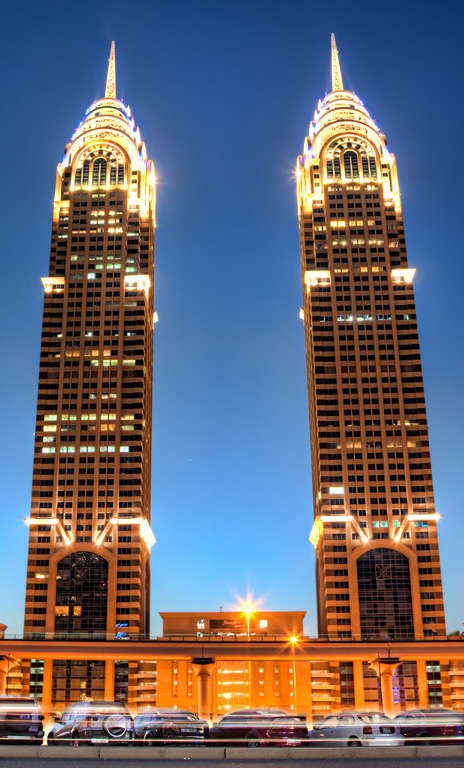
We should not hide the fact that there are also numerous problems with the 'Dubai Miracle':-
Is it logical to build the tallest skyscrapers, the greenest golf courses, and even indoor sky slopes, in a desert?
Dubai residents consume 10% more water than the average American.
Almost all of Dubai's water comes from desalination, which is expensive both in terms of energy consumption and environmental impact.
The construction of artificial islands damages the natural shoreline and changes tidal currents.
Waste treatment can't keep up with the expanding population.
Migrant workers are the modern slaves, with inhuman working and living conditions.
And finally, is the 'Dubai Miracle' economically viable in the long-term?
Today the Sheikh Zayed Road is what is called an 'urban canyon', a feature of an urban heat island. This concentration of human activity forces urban buildings to spend more on cooling, thus increasing peak electricity load and CO2 emissions.
What they should have done was increase green areas, use cool sinks for heat dissipation, introduce natural ventilation, and focus on creating urban canopies that reflect back sunlight. A district cooling system might well have provided the best solution.
Iconic Architecture
We have looked at what was visible from our hotel terrace, and I've prepared separate webpages on The Mall, the Burj Khalifa, and the Jumeirah Beach area. We have also looked at why iconic architecture is so important to Dubai, so now we can sit back and look at some of the most iconic buildings built in the region.
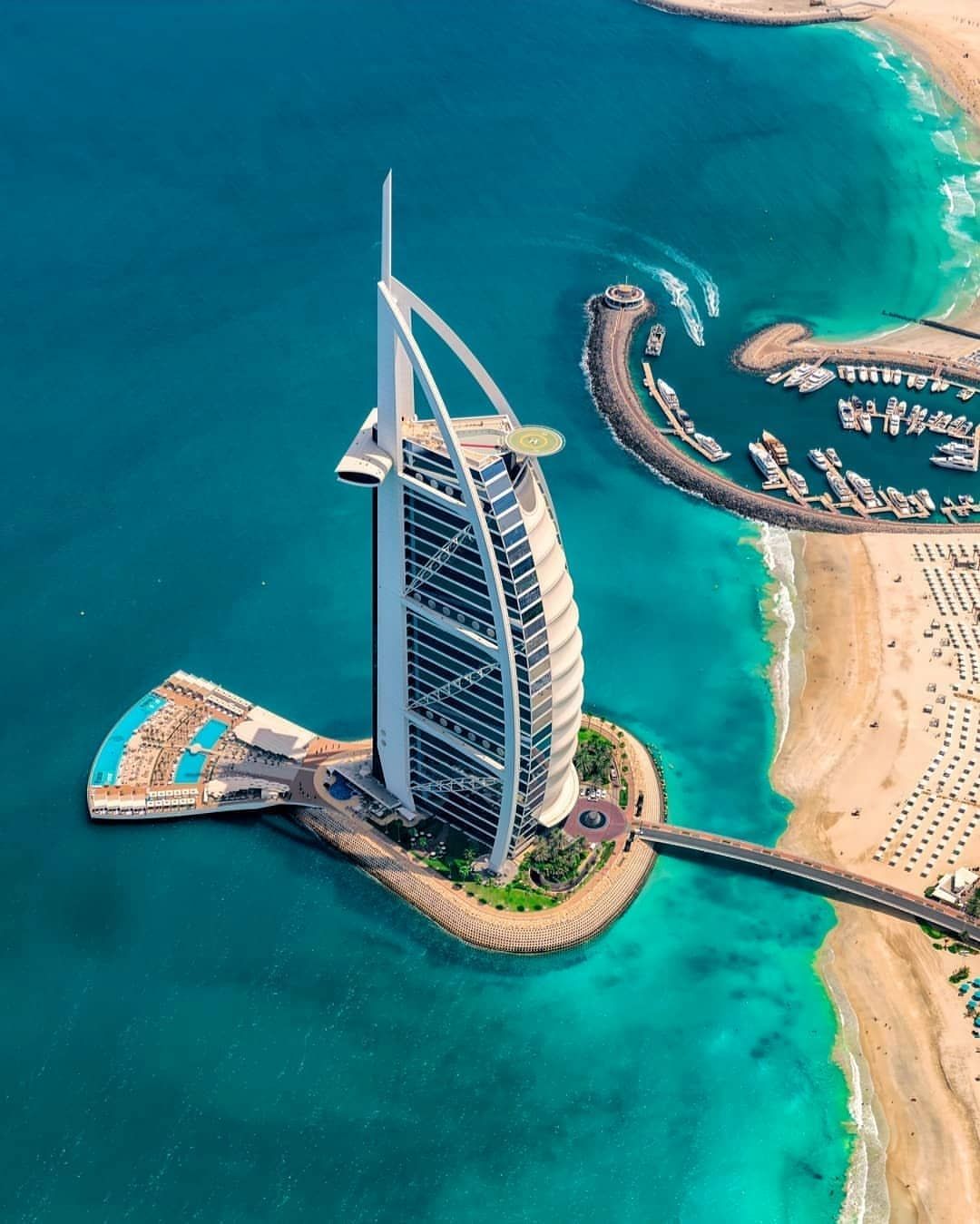
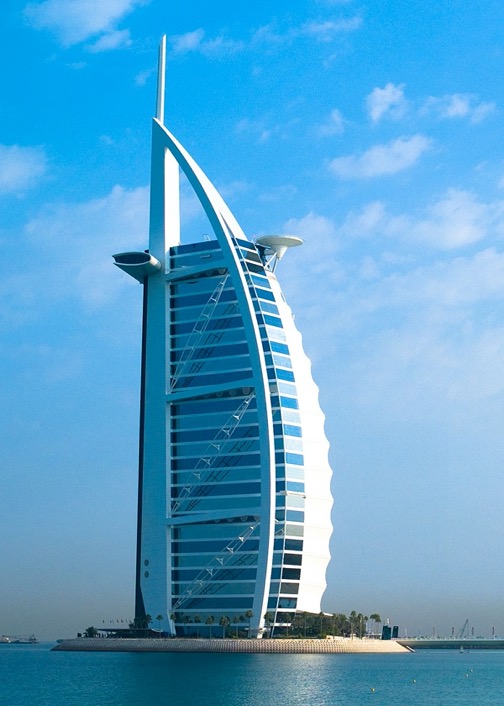
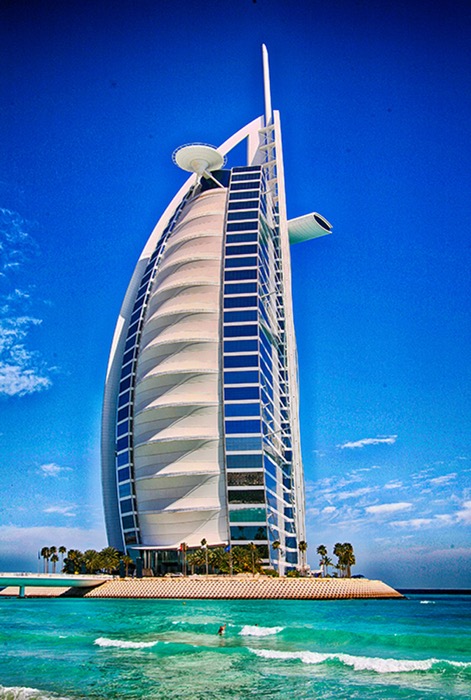
Possibly even more iconic than the Burj Khalifa is the Burj al-Arab hotel, designed by Tom Wright, built on a private artificial island, and completed in 1999.
As they say "the client is always right", and the client wanted not just a hotel, but a signature building, a statement that would announce to the world 'Welcome to Dubai'. Along with the Sydney Opera House and the Tour Eiffel, the Burj al-Arab has become one of the world's most symbolic buildings.
The approach of the architect was what is called 'structural expressionism', i.e. where the structural components of the building are visible on the outside as well as on the inside.
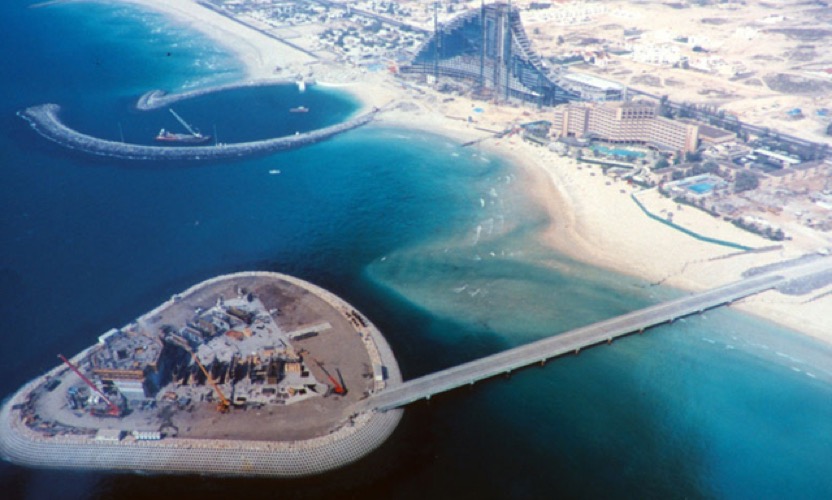
The decision to build an artificial island 280 metres from the coast was, at least in part, driven by the idea not to cast a shadow over the coast line.
The first 3 years was spent reclaiming the land, leaving less than 3 years for the actual construction. It was decided to protect the island using concrete honeycomb blocks designed to reduce the impact of the waves. So it all started with piles driven into the sea bed, and along with tie rods, providing a support for the boundary rocks. Boundary rocks were placed on either side of the piles. Then a hydraulic filler was used to displace the water from the inner part of the new island.
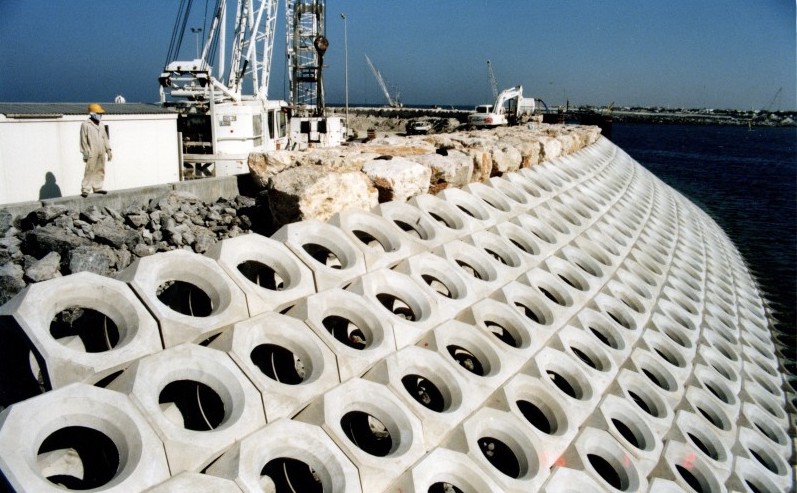
Then the concrete honeycomb blocks were added as wave protection. Now they could start the foundations with 250 columns, 45 metres long and 1.5 metres in diameter. The interesting thing is that the foundation columns remain in place due to what is called 'skin friction drag'. In very simple terms the drag or viscous force applied by the sand on the columns is greater than any inertial force applied by the structure, so the columns don't move and the foundations are stable. Now the island interior was excavated and a 2-metre thick concrete plug slab laid as a base for the building.
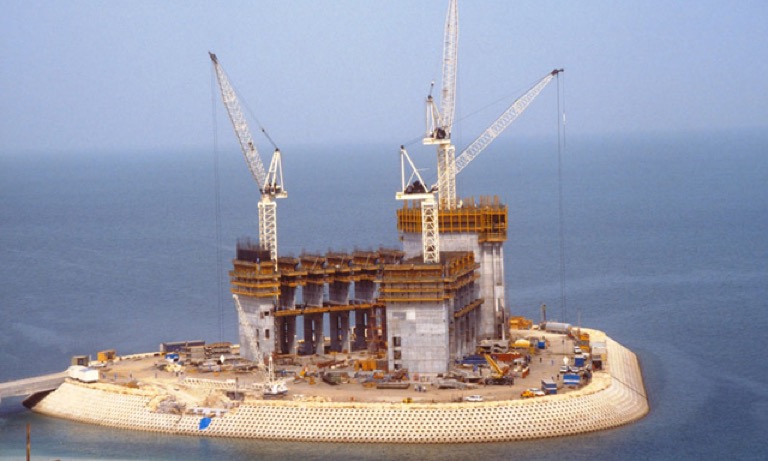
The main part of the building is a V-shape form using prefabricated concrete sections, with cross braces holding the two arms of the 'V' together. The enclosed structure consists of 28 double storeys (so 56 storeys in all) and the total structure involved 9,000 tons of steel and 60,000 square metres of reinforced concrete. This entire 'V block' is held together by a so-called exoskeleton frame, i.e. as with a crab it's the shell that provides support and protection. Below we can see the 'V' which actually makes up the interior structure of the hotel (e.g. bedrooms, bathrooms, stairs, lifts, etc.), and we can see two arms of the exoskeleton frame taking shape.
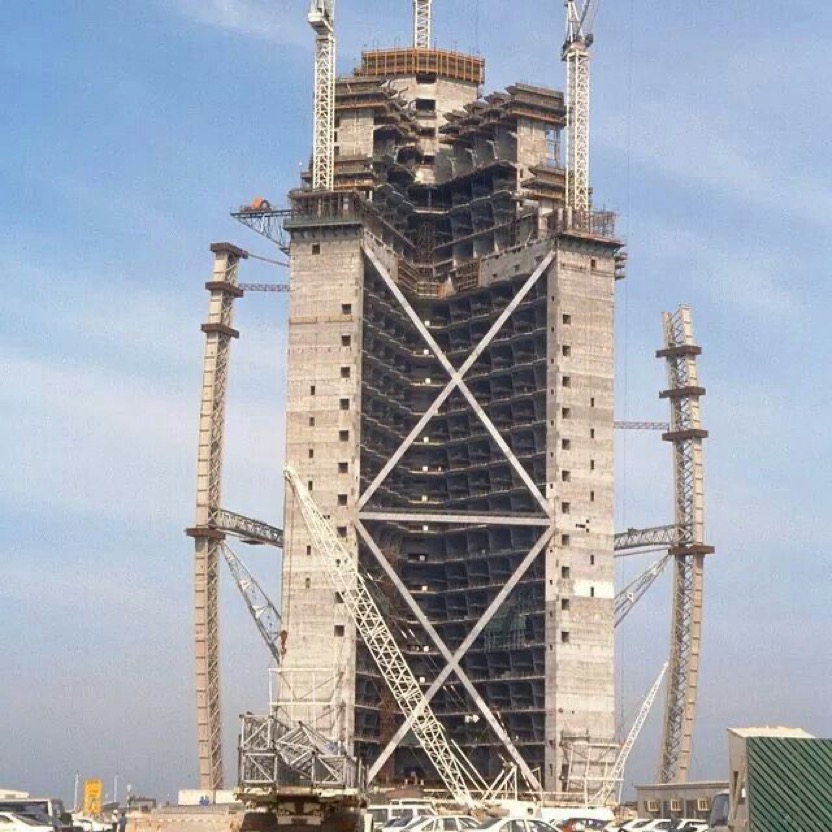
I think now is a good moment to check it out in this video.

Above we can see components arriving on the site, and in the background we have the structure taking shape with the cross braces in place.

Here we can see steel exoskeleton frame attached to the reinforced concrete spine by lattice brace members. In the final design you will also see huge tubular triangular trusses fixing the two legs to the central core. These trusses can move by up to 5 cm as the building moves to take up any stress placed on it by wind, daily temperature changes, etc.
The location is subject to very strong winds and occasional violent thunderstorms. So wind tunnel tests were performed for winds approaching 160 kilometres/hour (45 m/s). Also seismic studies were performed because southern Iran (just 100 kilometres away) is known as a moderate earthquake risk.
If you look carefully at the two exoskeleton arms they are actually made up of a clad lattice structure. Most people think of these large structures being very solid and stable, but in fact they move and sway with the winds, and with possible seismic events. The buildings are designed to withstand those movements, but in addition that movement can induce vibration, which can cause severe discomfort to the building occupants. These vibrations are caused by what are called vortex shedding. Vortices are created behind a body as non-laminar air flows over it. A low pressure zone is created and the object will tend to move towards that low pressure. The low pressure zones are not constant, the pressure goes up and down with a certain frequency, moving the building back and forth with that same frequency. The real problem occurs if the frequency of the vortex shedding matches the resonance frequency of the structure. One way to address this problem is to make the structure stiffer by making the components bigger and thicker (i.e. changing the resonance frequency of the structure). This increases the cost, and is inelegant given that there is often an alternative. One alternative is called tuned mass damping (TMD), also sometimes called a 'harmonic absorber'. Below we have an example of a vertical TMD often used in large tower blocks (there are also horizontal TMD's used in bridges, etc.). The idea is simple, and we just have to imagine a building being 'hit' by a gust of wind. It will move a bit, but will move back again. However it will not just move back, it will oscillate slowly back to its original position. The building will have an inherent damping, but that slight oscillation can cause discomfort. Everything will depend upon the design and the construction materials used. In very simple terms a massive suspended weight inside the structure will act as a counterweight, absorbing some of the energy developed during the 'excitation' of the structure. The counterweight is set in motion and moves in the opposite direction to the initial movement of the structure. It means that the structure moves less, and will stop its oscillation quicker. The key is to 'tune' the weight to the resonance frequency of the structure. As you can see below, it is a massive suspended weight, which is designed to move and dampen any vibrations that come close to the resonance frequency.
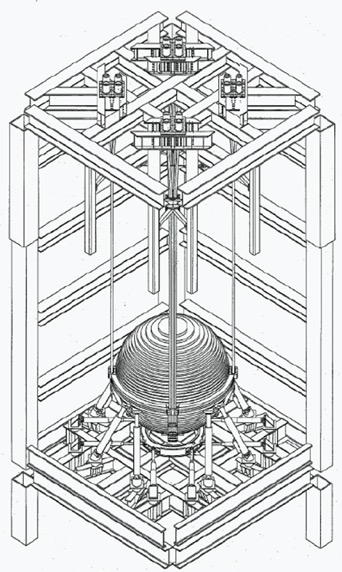
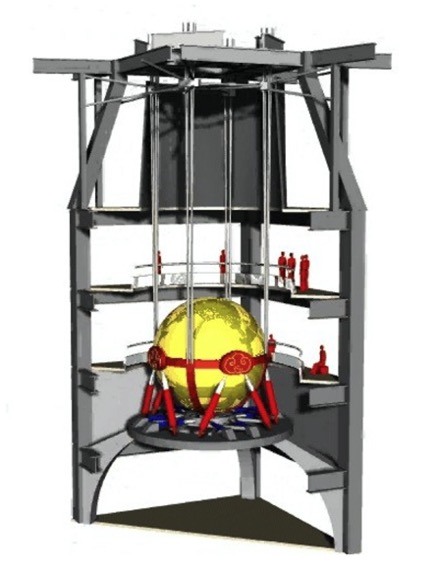
The one we see above is actually from Taipei 101, it sits on top of the tower, and weighs 730 tons. As you can see there are observation balconies, and today it's actually open to the public and has become a popular tourist attraction. It's worth noting that the 730 ton steel sphere will swing by more that one metre when the building is hit by 160 kilometre/hour winds.
In Burj al-Arab there are eight 5-ton tuned mass dampers installed inside the exoskeleton arms, and another three 2-ton tuned mass dampers inside the 60 metres spire. Below we have an example of the dampers installed in the arms.
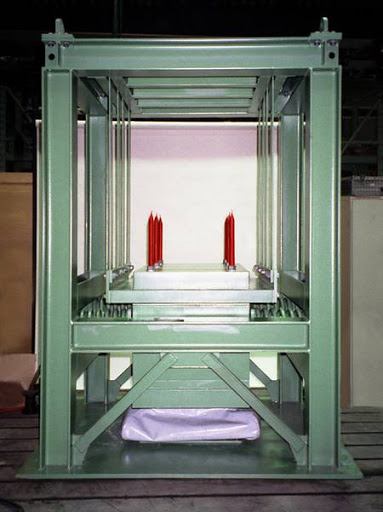
This is not the only approach that can be taken for supplemental damping systems, for example there are viscous and viscoelastic dampers, as well as tuned liquid columns dampers and tuned sloshing dampers. The challenge is to ensure that the technique used covers all the operational amplitudes likely to be encountered in real life.
It is interesting to note that the Burj Khalifa does not employ tuned mass dampers. The buildings structure, stepped profile, and the use of an efficient internal wall system, is sufficient to both 'confuse the wind' (reducing vortex shedding), and provide stability against the lateral forces.
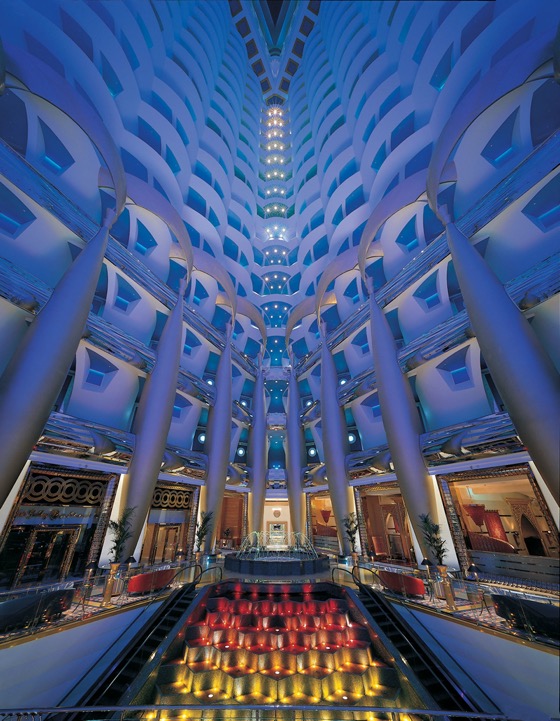

The completed V-shaped floor plan, supported by the exoskeleton frame, creates the world's tallest atrium (180 metres) which is enclosed by a north-facing, 15,000 square metres, 200 metres high membrane façade. The façade is actually made up of 12 individual tensioned, two-layer, translucent panels. The material used was a PTFE fibreglass fabric membrane. The key was to minimise heat gain during the summer months. The material used is light weight, UV immune, and reflects 75% of the sunlight, but allows 15% to pass through (absorbing 10% as heat). It's important to mention the two-layer membrane because the heat that passes through the outer membrane is removed by a flow of air between the two membranes.
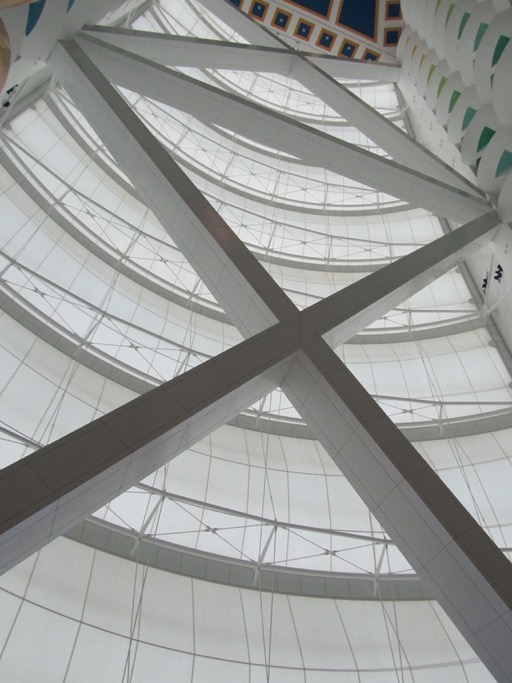

Another problem was the suspended restaurant and helipad.

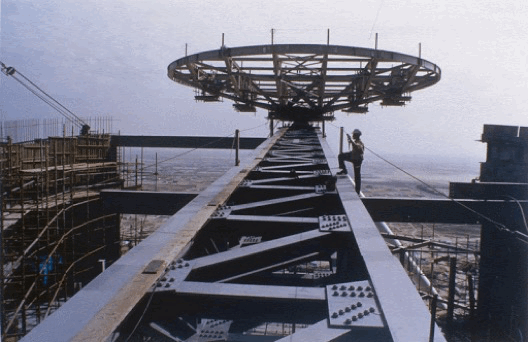
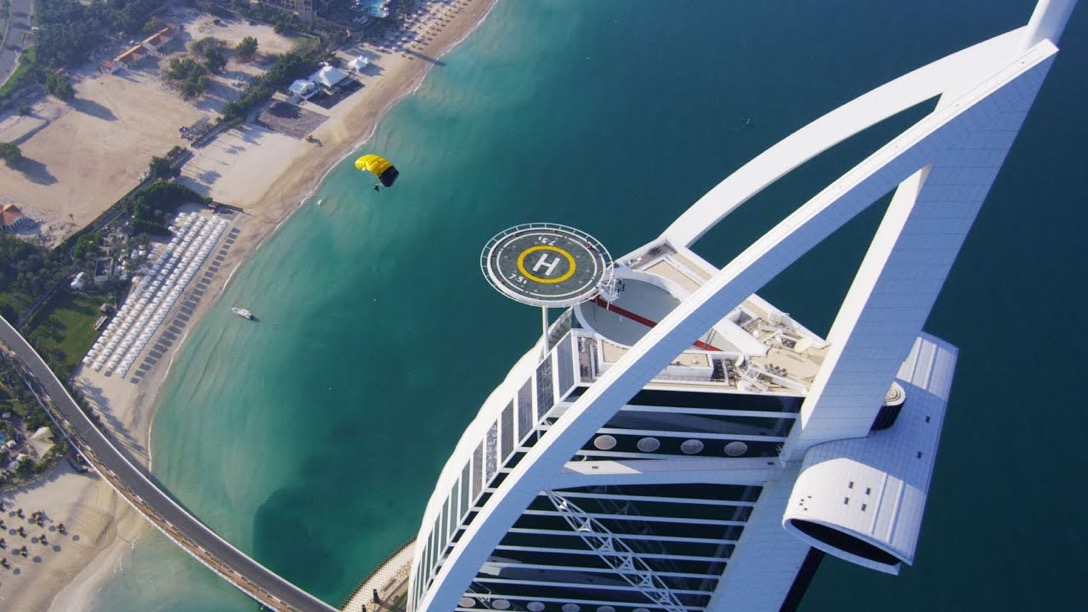
One finally element, that is often forgotten, is the 10,000 square-metre private terrace. It is in fact not built on the island, but extends out above the sea.
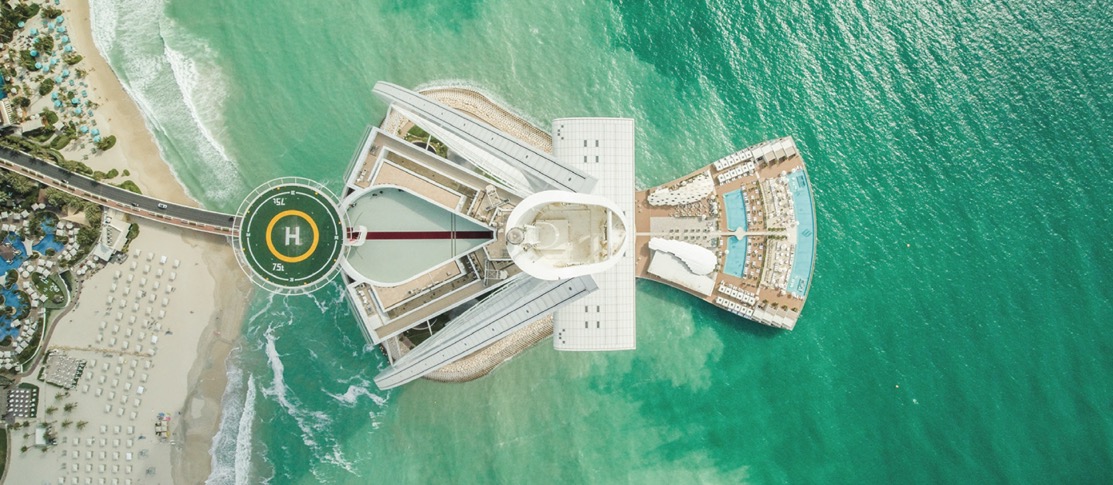
It was built in six sections in Finland and shipped out to Dubai. The total weight is about 3,000 tons. Check out the video from the builders.
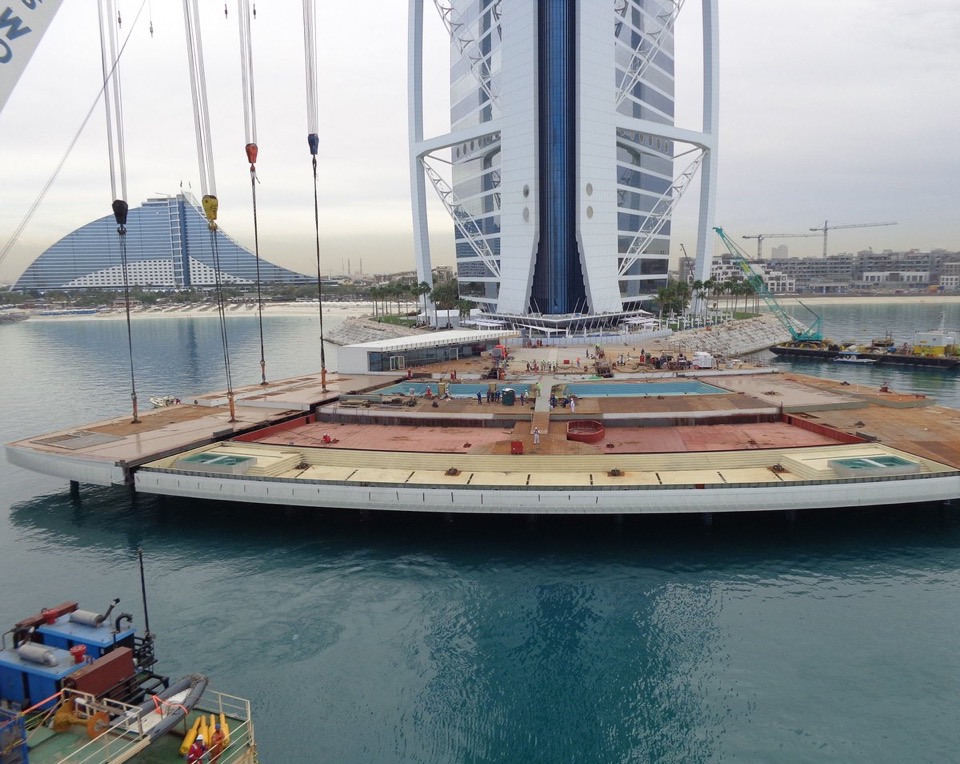
Before we move on, here is a little list of the elements that went into the hotels decoration and completion:-
Often you read that the inspiration for the design was a dhow, but the architects actually say that the inspiration was the billowing spinnaker sail of a high-tech J-class yacht.
The cost of the building was estimated at $650 million, and the total cost with interior decoration, etc. is estimated at $1 billion.
I think that the Burj al-Arab was the world's first 7-star hotel, however the rating is self-referential, and there are other hotels that also now claim to be 7-star. I've read that the Burj al-Arab is even being mentioned as an 8-star hotel.
It also claims to be the world's tallest all-suite hotel in the world.
The total height of the hotel with the spire is 321 metres, and the total weight of the hotel has been estimated at 250,000 tons.
The hotel is home to the world's tallest atrium at over 180 metres in hight, and in fact nearly 40% of the interior space is not used.
The hotel has 28 double storeys containing 202 duplex suites, the smallest is 170 square metres and the largest 780 square metres.
There are 30 different types of Statuario marble used, covering nearly 24,000 square metres.
The Al Muntaha restaurant is suspended 200 metres above sea level, weighs 350 tons, and hangs out 27 metres above the sea on 10 steel cantilever beams.
The Helipad also sits at 212 metres above the sea, and weighs 330 tons.
The Terrace is a separate steel structure weighting about 3,000 tons, and it's 2 pools are home to 10 million mosaic tiles in shades of azure and gold.
More than 1.8 million floral creations are made each year, and the hotel uses more than 45,000 roses each month.
The hotel has its own fleet of white Rolls-Royces for its guests.
Around 1,300 people work in the hotel.
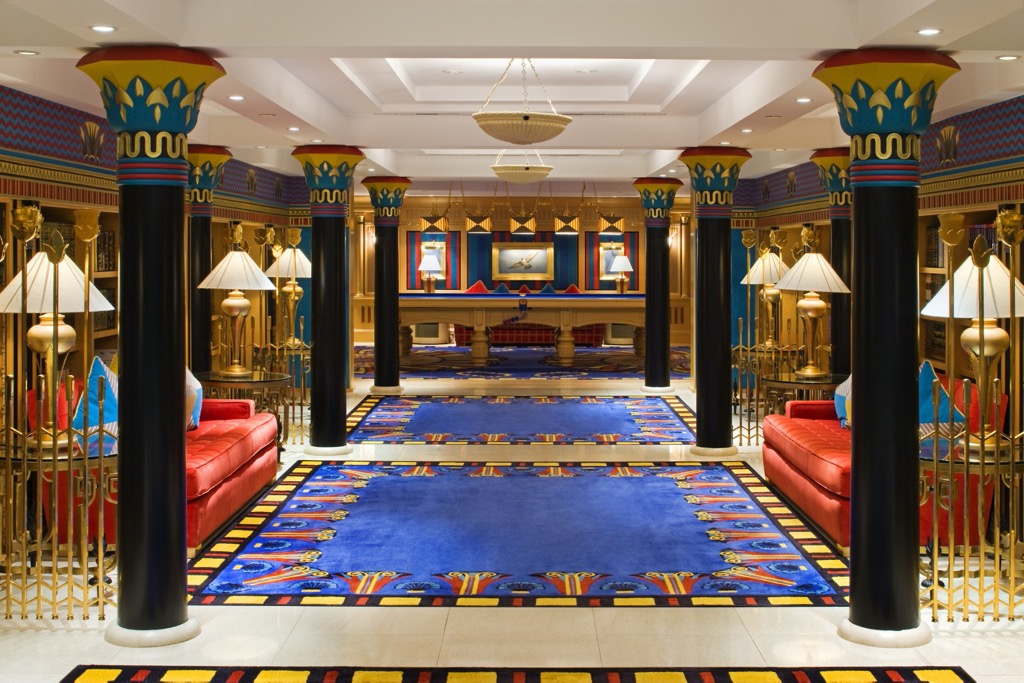


The Burj al-Arab has clearly achieved its objective. It is one of the most iconic buildings in the world, and is the symbol of Dubai. However some people have tagged both Dubai and the Burj al-Arab as a "triumph of money over practicality". I personally admire the contemporary design of the building, and the engineering that went into its construction. However, as seen above, I am not a fan of the interior decoration. Personally I find it tacky and more than occasionally a perfect example of bad taste. I have always been amazed as to how people can use the best materials, employ the best craftsmen, spend eye-watering amounts of money, and yet achieve the wrong effect. It would not stop me spending a night there, if I had money to burn.
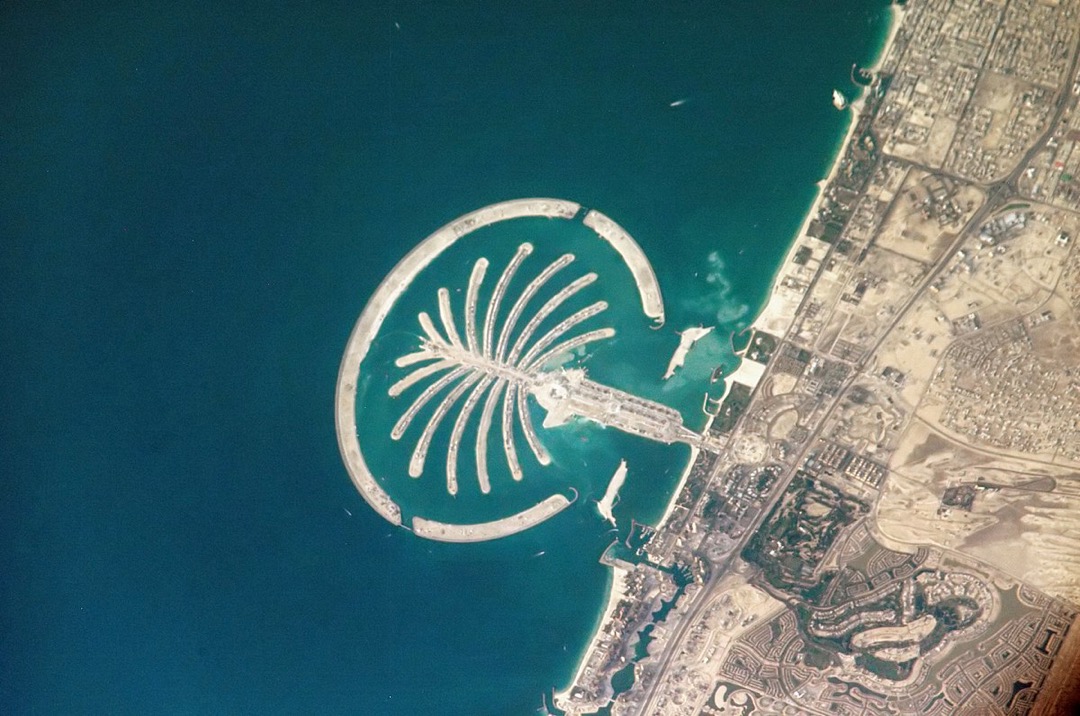
The Burj al-Arab is one of the top icons of Dubai, along with Burj Khalifa. I was quite surprised to learn that for people living in and visiting Dubai, the Burj Khalifa tops the visual icon 'hit list', beating the Burj al-Arab into second place. Our next example of iconic architecture in Dubai came a close third, the Palm Islands.
I was even more surprise when I turned to what has been called 'experiential icons'. Burj Khalifa still tops the list but Ski Dubai comes in second, followed by Burj al-Arab. It would appear that the Palm Islands might look visually attractive, but they don't deliver as iconic experiences. The islands are beaten out of 4th place by Dubai Creek, and out of 5th place by the Dubai Metro. In fact, I would even give the edge for 6th place to the Jumeira Mosque.
Interestingly, as an iconic piece of architecture Burj al-Arab comes in first, closely followed by the Emirates Towers, leaving Burj Khalifa in third place. Palm Islands comes in with a very average 4th place.
So the Palm Islands might look nice and work as recognisable visual icons, but they are far from being a compelling tourist attraction.
Why build artificial islands? It looks like the equation is simple. On the one had the objecting is to welcome 15 million tourists annually to Dubai. But Dubai only has a natural coastline of about 72 kilometres. The solution, build artificial islands to increase the coastline, and it all starts with the Jumeirah Palm Island.
The Jumeirah Palm Island adds 78.6 kilometres of additional coastline, covers an area of 5.6 square kilometres, has an 12 kilometre breakwater, provides space for 40 hotels and 60,000 residents, and costed $6.5 billion. At the time of building, this was the world's largest man-made island.
The Palm Islands consists of three islands, Palm Jumeirah spanning about 20 square-kilometres, Palm Jebel Ali spanning around 40 square-kilometres, and Palm Deira covering around 80 square-kilometres (the size of central London). In addition The World is an artificial archipelago of 300 small islands. It should be noted that other countries have built or are looking to build artificial islands, namely Saadiyat Island in Abu Dhabi, Al Noor Island in Sharjah, Durrat Al Bahrain and Amwaj Islands in Bahrain, and Pearl Island in Qatar.
The next question was how do you build an artificial island? The answer to this questions comes in two parts. First the materials, and second the machines.
The raw materials were stone from sixteen quarries opened across the UAE, and 11 kilometres off the coast. The sea bed provided course sand resistant to wave impact (the local dune sand was too fine and flaky). The island required 9 million tons of rock and 110 million cubic-metres of sand.
The second part of the answer was 9 barges, 15 tugboats, 7 dredgers, 10 floating cranes, and 30 heavy land-based machines (e.g. vibro-compactors, cranes, bulldozers, etc.).
This is 'nothing', The World required 40 million tons of rock and 320 million cubic-metres of sand, and Palm Deira required 45 million tons of rock and 1 billion cubic-metres of sand.
The reclamation and ground improvement work started in 2001, took 27 months, and was completed four months ahead of schedule.
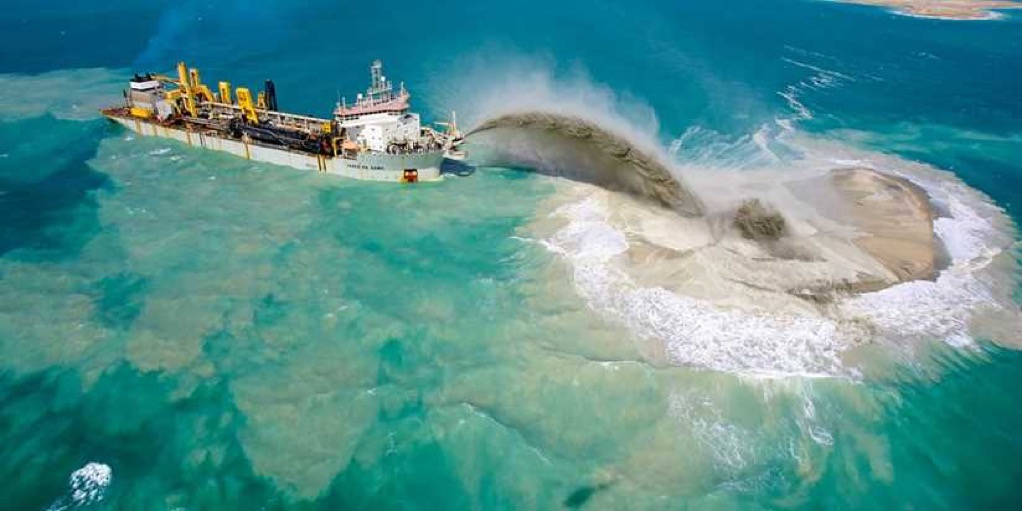



An interesting question arose as to how to decided where to put the rocks and sand. The answer was that each day five men walked around the entire island carrying a GPS device connected to a satellite system. The height and location of the men showed where the sand was and where additional deposits were needed.
Then came the infrastructure, with roads, water supply, sewerage, electricity, district cooling and communications.
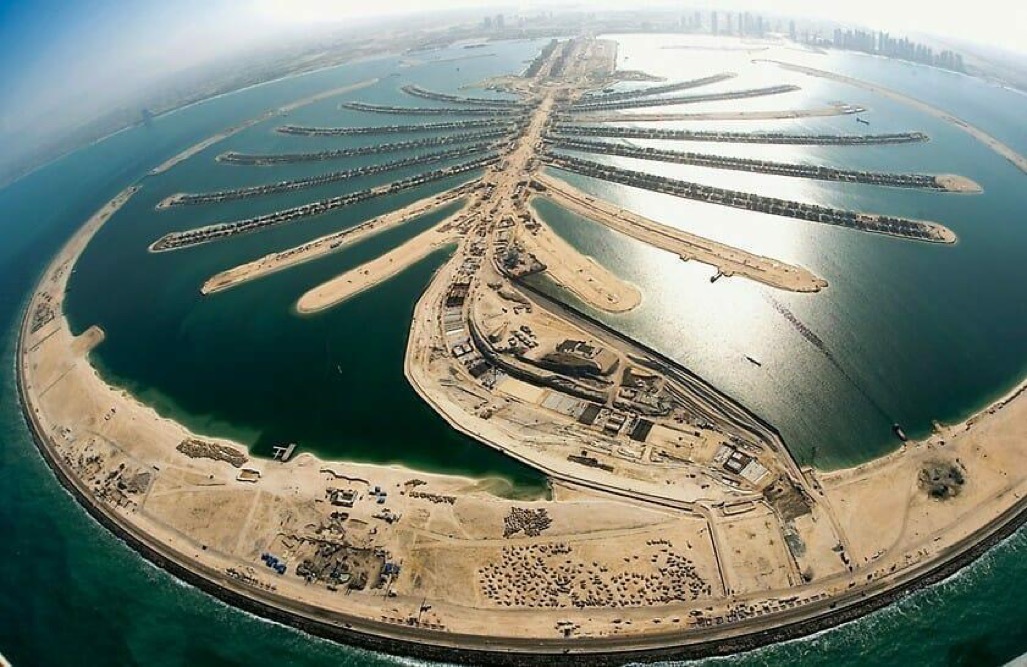
Followed by the construction of 40 hotels, 18-hundred beachfront villas, and 2,400 apartments.
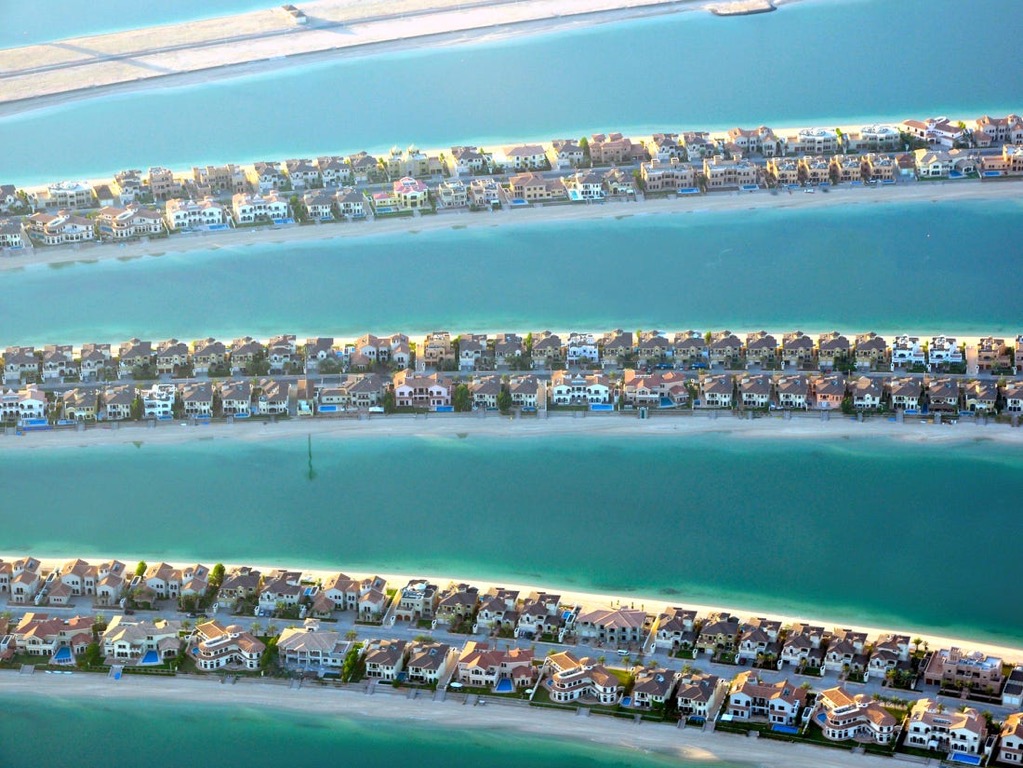
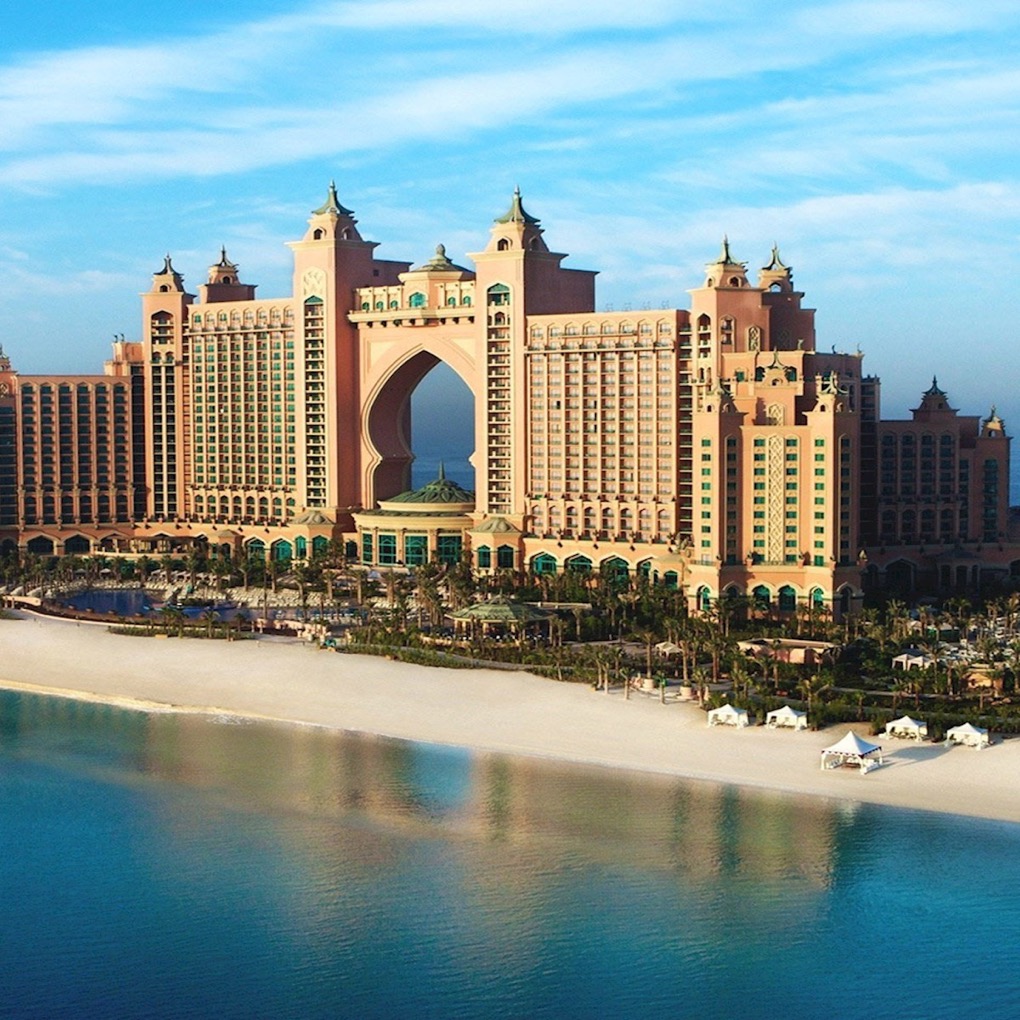
And not forgetting a marina, restaurants, shopping malls, sports facilities, a public transport system, and a water theme park.
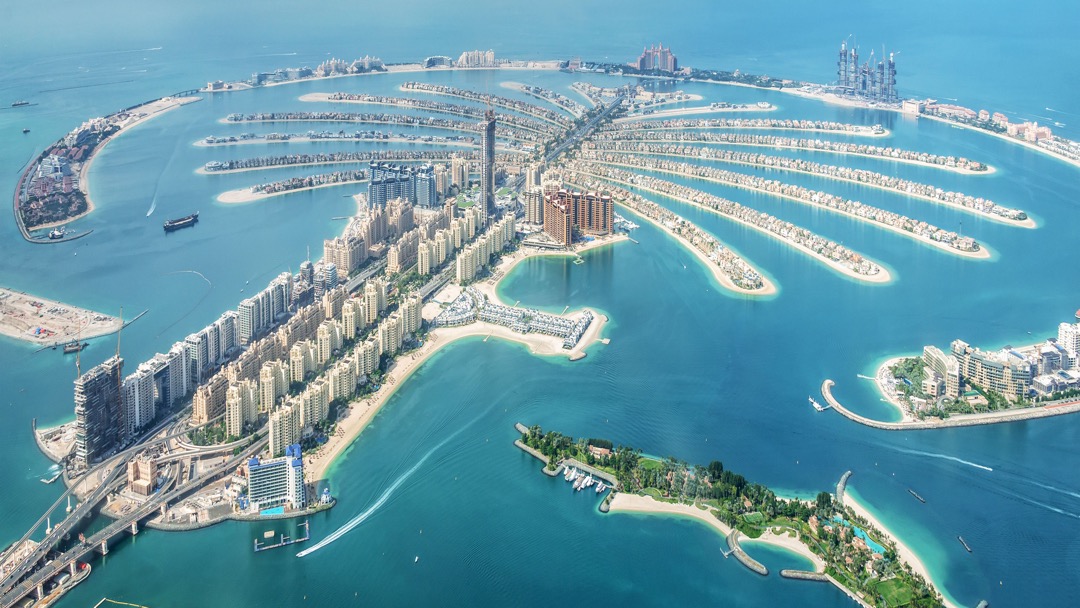
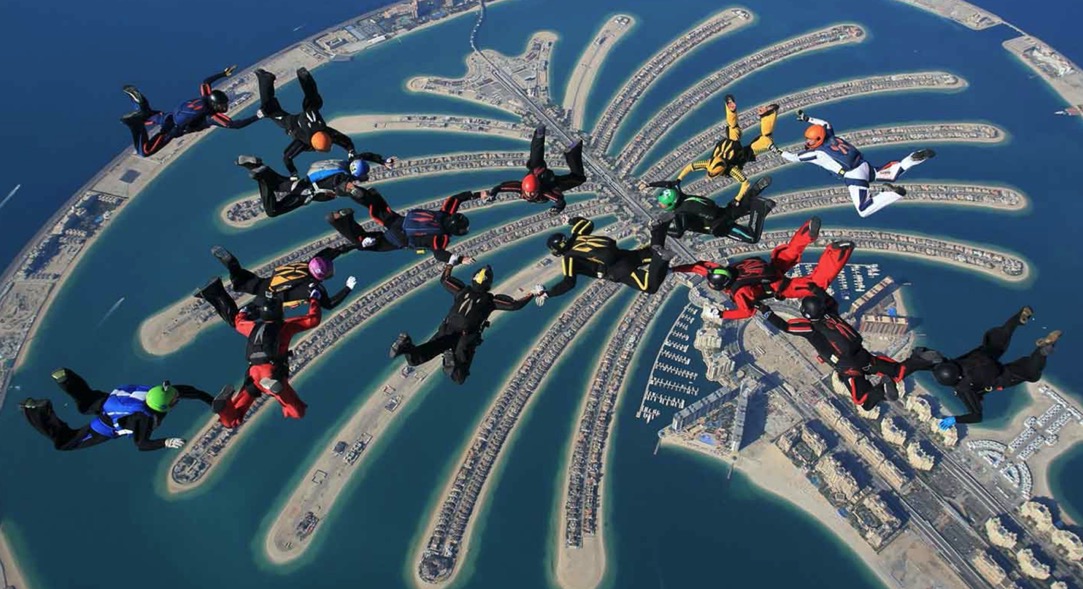
As an interesting aside, a test reef was built at the same time as the initial development work was on-going. The conclusions were that in the period 6-26 months the reef became an impressive habitat for a wide range of organisms (corals, molluscs, crabs, etc.) and many species of fish. It was noted that the Persian Gulf is quite shallow and consists of dense, saline waters with a high temperature. Thus it's a harsh environments for many species, including coral communities. What was found was that the organisms, once installed, improved the water quality, scavenged and removed dead and decaying detritus, and acted as a target for several types of fish and shellfish. This started to make the reef interesting to local fishermen. In addition, the flora that photosynthesised and produced oxygen aerated the water improving the reef as a useful ecosystem for local fish. The encrusting of the reef will help combat wave action and erosion, and already makes an interesting place for diving and tourism. So a surprisingly positive view even if it looks as if the reef was attracting organisms and fish from the deeper, rocky seafloor, i.e. changing the existing eco-system.
I understand that in order to make the artificial island even more interesting for diving and tourism, they have sunk two F-86 jets, a passenger airplane and a London bus.
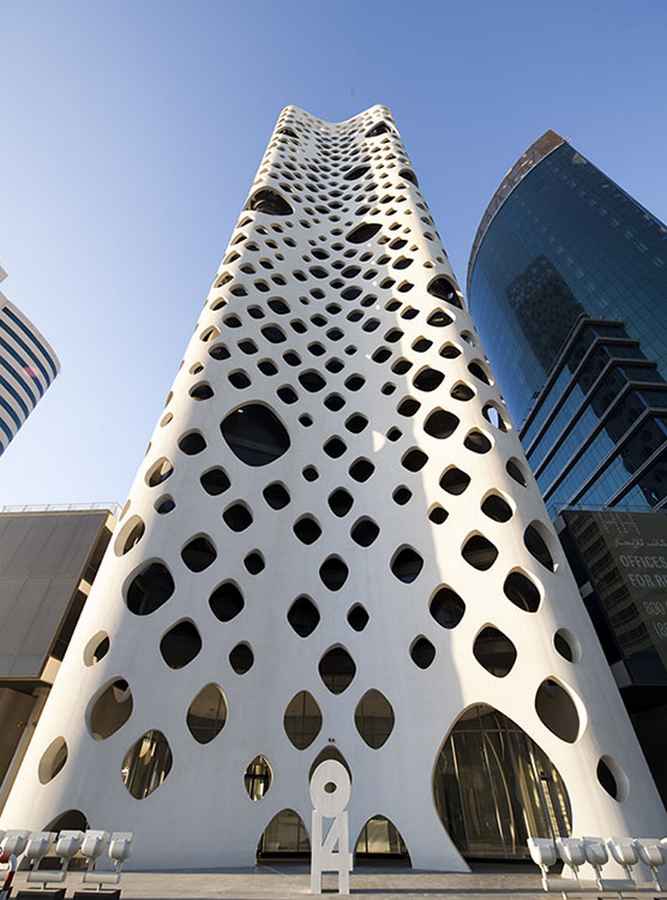
Our next iconic building is poles-apart from Burj Khalifa, Burj al-Arab and the Palm Islands. It is the 102-metres tall O-14 building in Business Bay, Dubai. This office building was designed by Reiser+Umemoto, and was completed in 2009. It consists of a 40-centimetre thick concrete exoskeleton perforated with over 1,300 openings to create a lace-like effect. The exoskeleton provides the structural resistance, and frees up an interior column-free open space. The shell also provides a sunscreen, openings for light and air, and providing the views from the interior floors. The space of nearly 1-metre between the shell and main enclosure creates a 'chimney effect', where cooler air is pulled in from outside, and as it heats up it rises cooling the glass wall of the interior core.
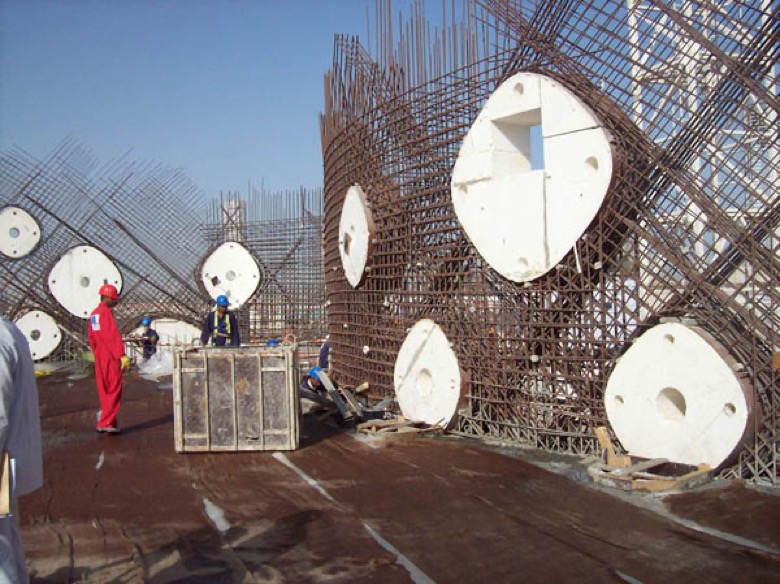
The holes were polystyrene void forms set into a structural matrix, and the concrete used was in a super-liquid form. It's not evident from the façade but more concrete is used where the structural loads are greatest.
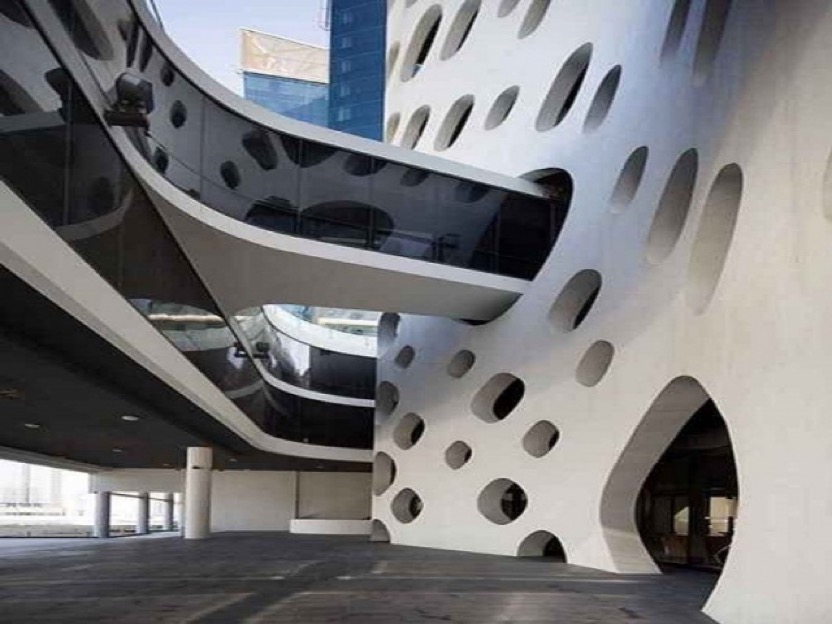
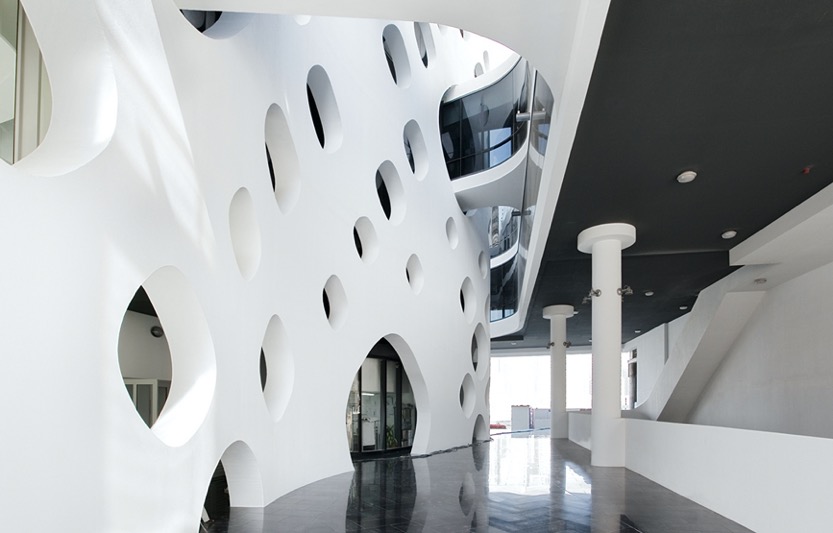
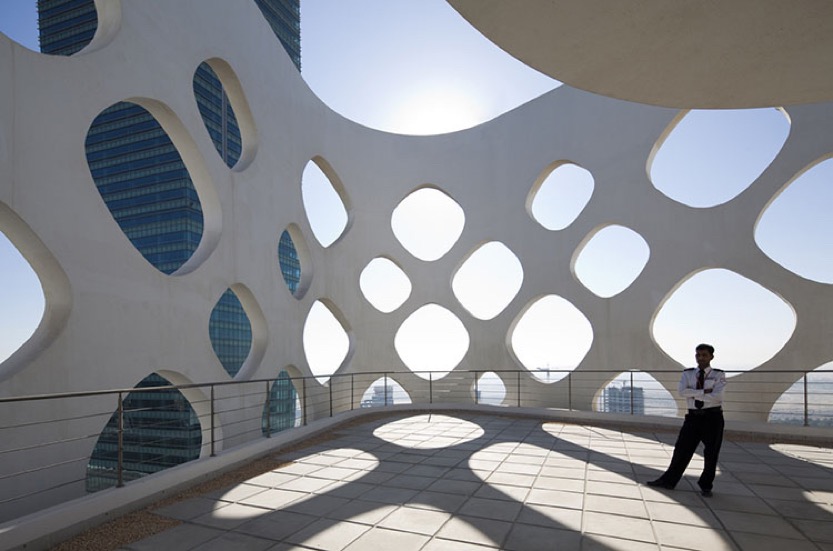
Now we return to what is far more obviously an iconic building, the visually impressive 310-metre Cayan Tower. This apartment building was designed by Skidmore, Owings & Merrill, and beyond the twist, there are a couple of additional interesting features which we will mention below.
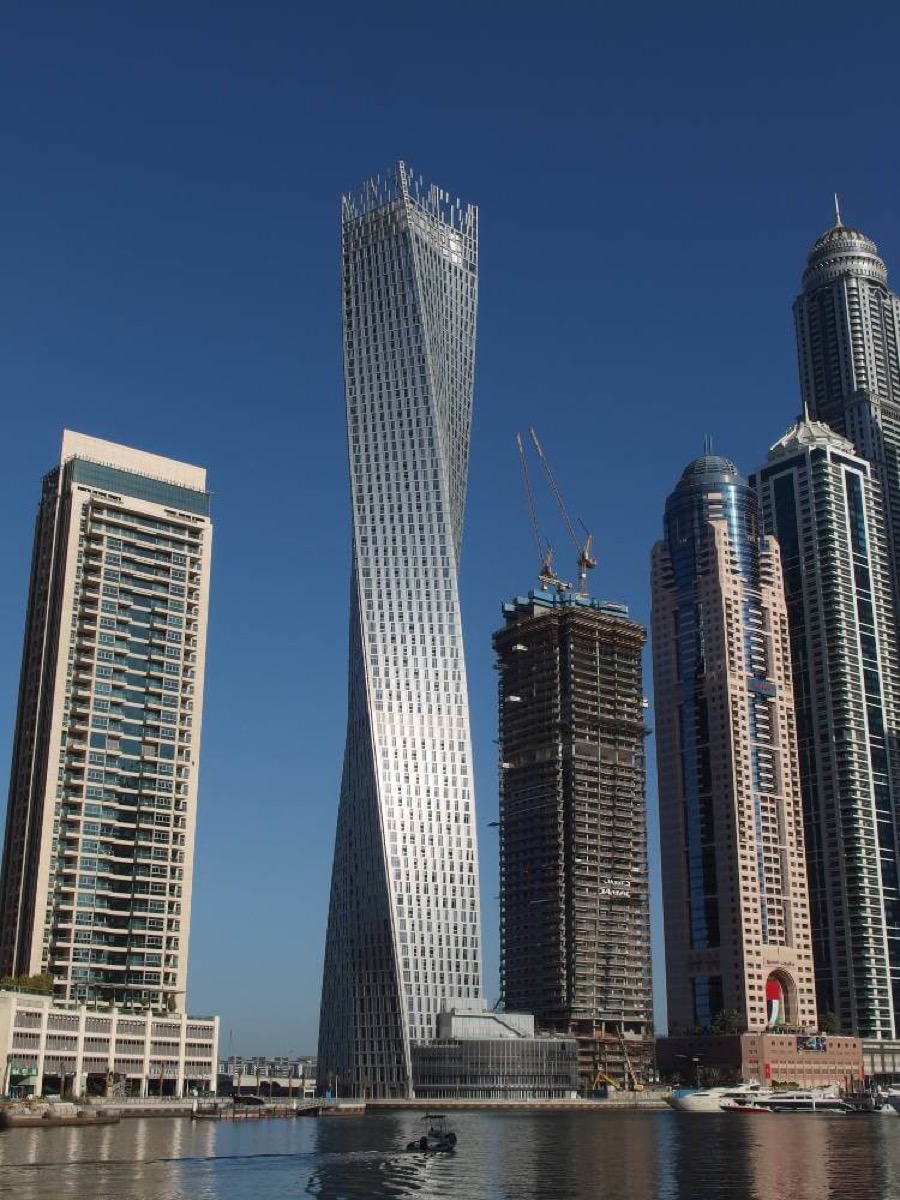
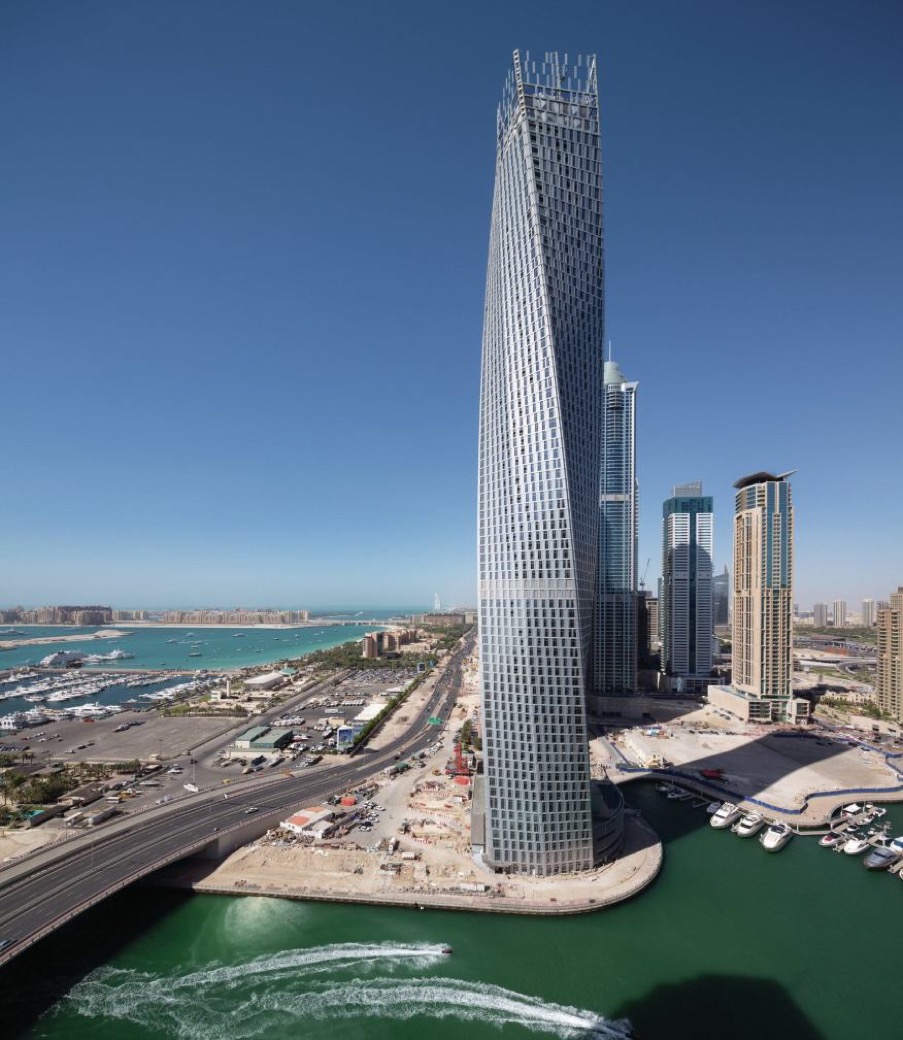
The idea is simple, it is a building with a simple square-shaped slab floor, where each of the 73 floor plates is rotated by 1.2°, completing a rotation of 90° from the bottom to the top.
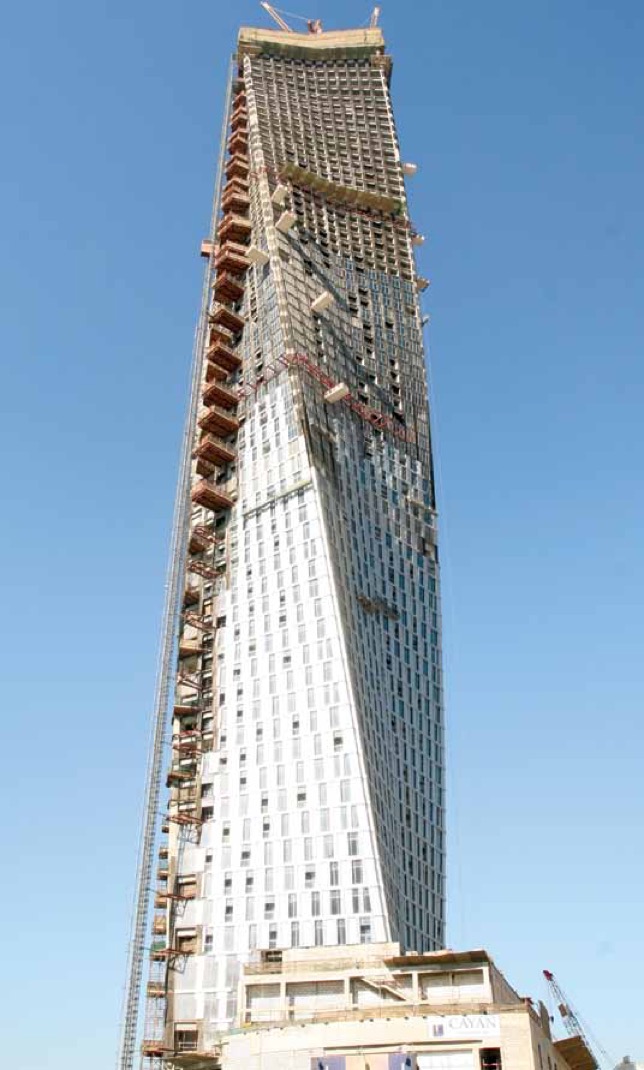
An alternative way to twist a building is to build a 'standard' tower building, and simply twist the external cladding. The problem with this approach is that it requires more columns and the floor plans change from one floor to the other. Rotating the floor plan requires fewer columns and the floor plan stays the same, even if the view changes. The trade-off is greater complexity in the structural design. By rotating each of the 73 floor plates by only 1.2° the columns only shift by about 30 cm, from one floor to the next, so structurally the columns on different floors still work as single columns penetrating through the entire height of the building.
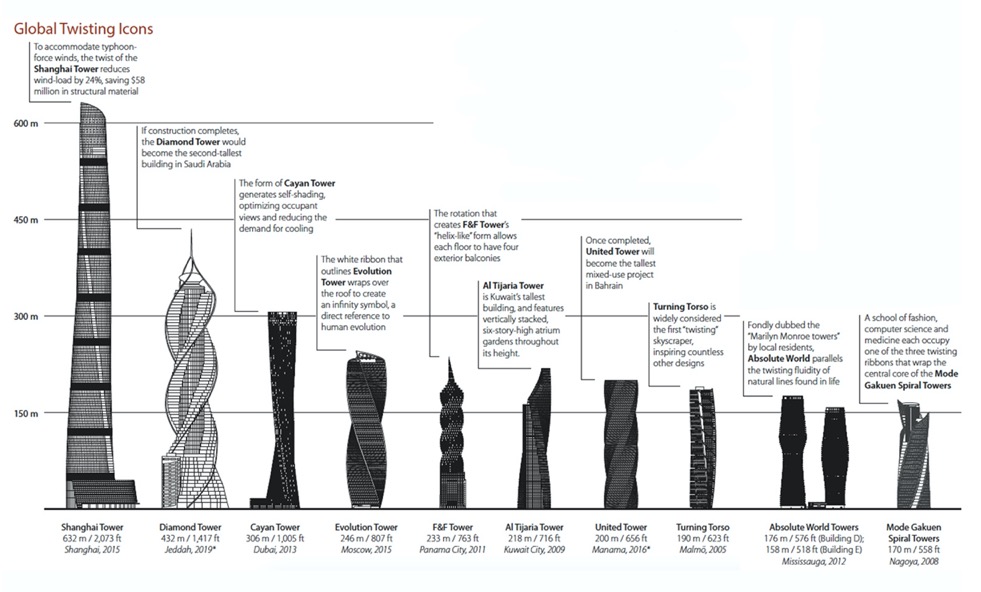
This building is one of a class of buildings that challenge the 'classical' rectangular tower, by adding a twist, a tilt (Gate of Europe Tower in Madrid), a taper (Lotte World Tower in Seoul), or even going with a free-form design (Federation Tower in Moscow). Twisting a tower is perhaps the least 'revolutionary' in that there were examples of twisted columns in Renaissance Italy. Generally twisted towers are structurally weaker that the classical tower columns, but twisted towers mitigate better wind-induced vibrations because they disturb the formation of alternating vortexes. Vortex-shedding can be the most critical structural design constraint for tall tower-like buildings, so the twisted form can be a valuable alternative.

One less obvious problem with this design was with the plumbing, where each bathroom and kitchen keeps moving from one floor to the next. The solution was to run all the services on each floor to the building's central core.
Above I mentioned that this building had a couple of 'invisible', but interesting features. The first is that the floor plan is in fact, not a pure rectangular, but a faintly chevron-shaped hexagon. The slight kink in the walls has no structural importance, but it actually enhances the apparent slenderness of the building when seen from afar.
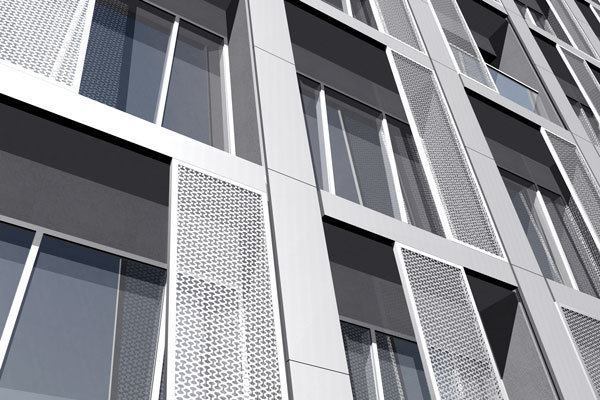
The other interesting feature is that the façade is made up of standard panels, but there are actually hundreds of balconies in recesses created by leaving a space between the curtainwall and the façade of outer latticework screens that work as sunshades.
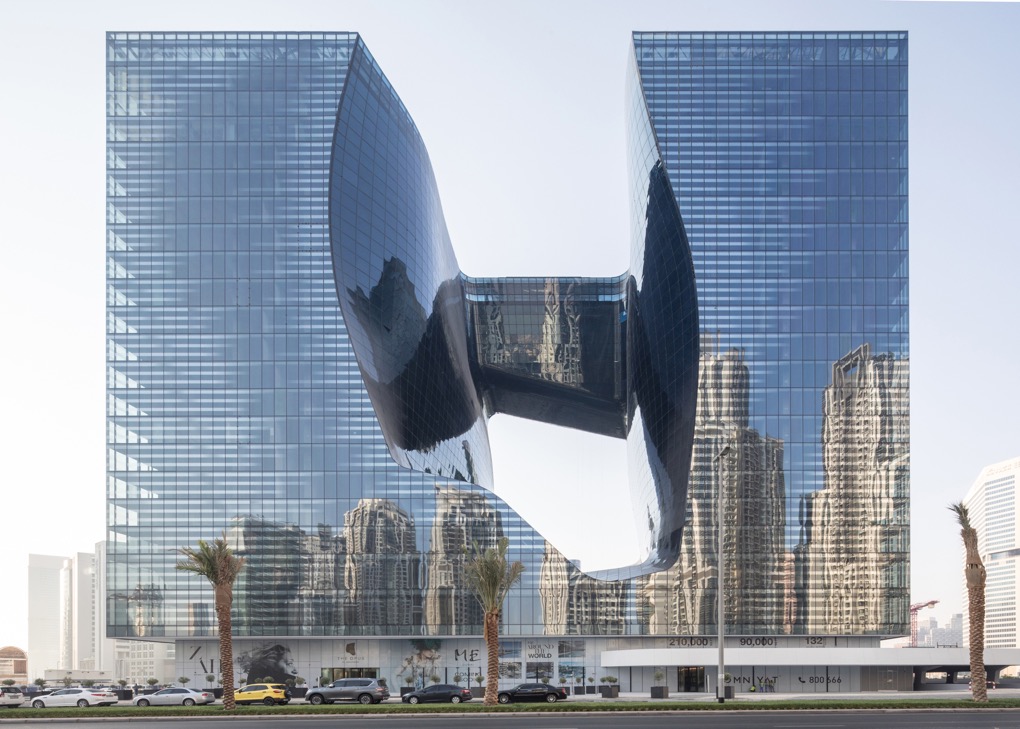
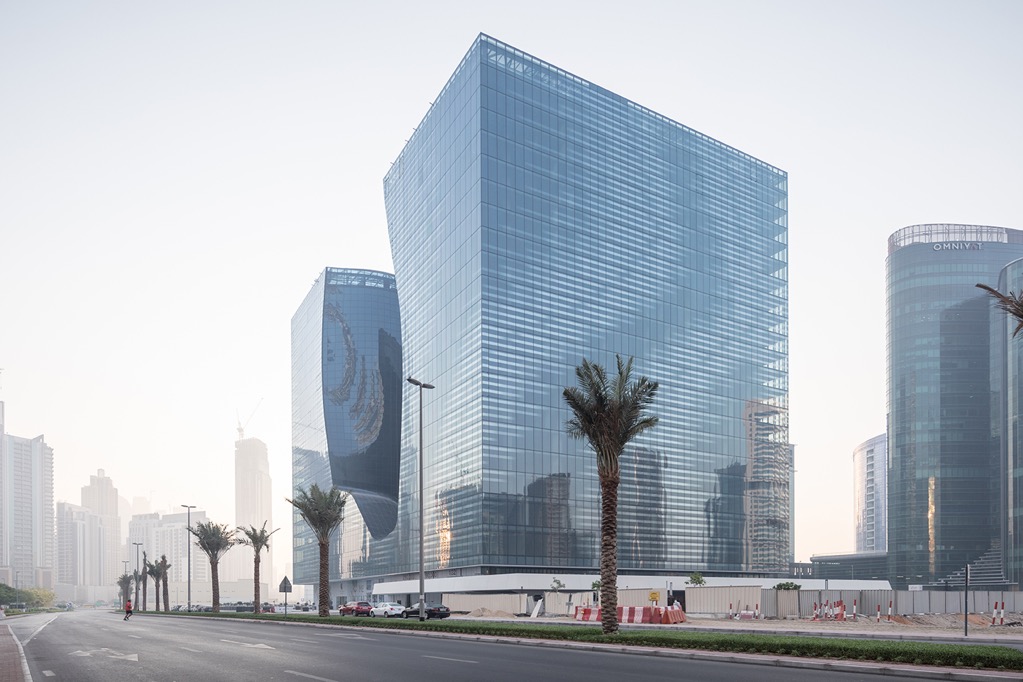
The mixed-use Opus Tower is the only building designed by Zaha Hadid in Dubai, and the only hotel where she created both the exterior and interior (check out brochure 1 and brochure 2).

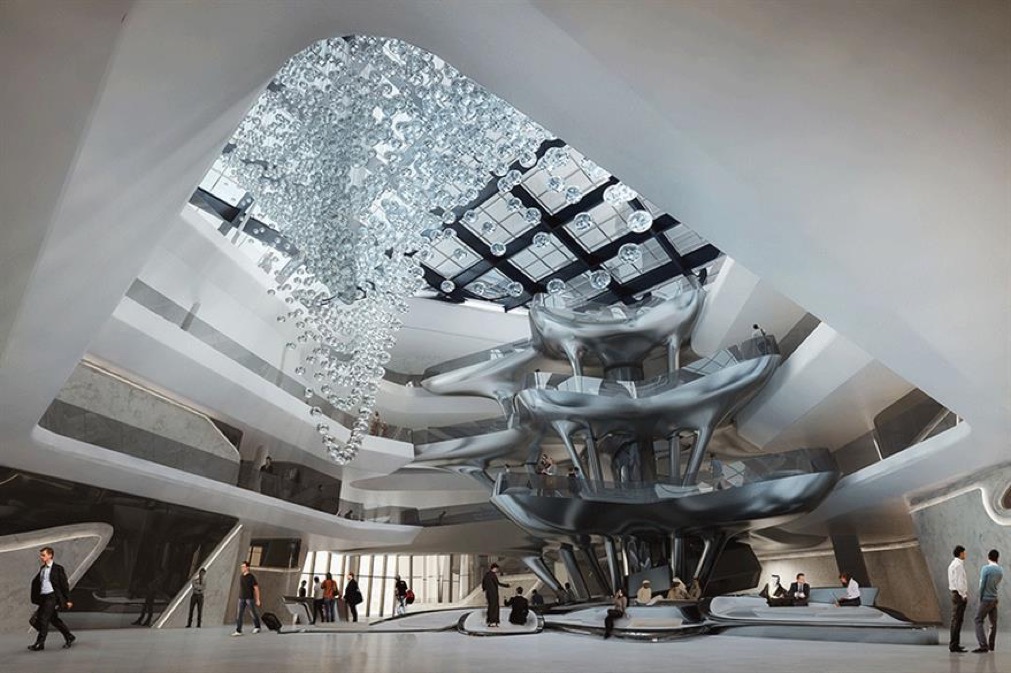
The basic design is for two 100-metres high towers forming a cube shape with an irregular eight-storey void in the middle. The towers are connected by a four-storey atrium at ground level and an asymmetric sky-bridge that is 38-metres wide and three-storeys tall, suspended 71 metres above the ground. The surface of the cube was designed to reflect its surrounds, and reduce glare inside the building. At night the void lights up. The cost was estimated at $460 million.

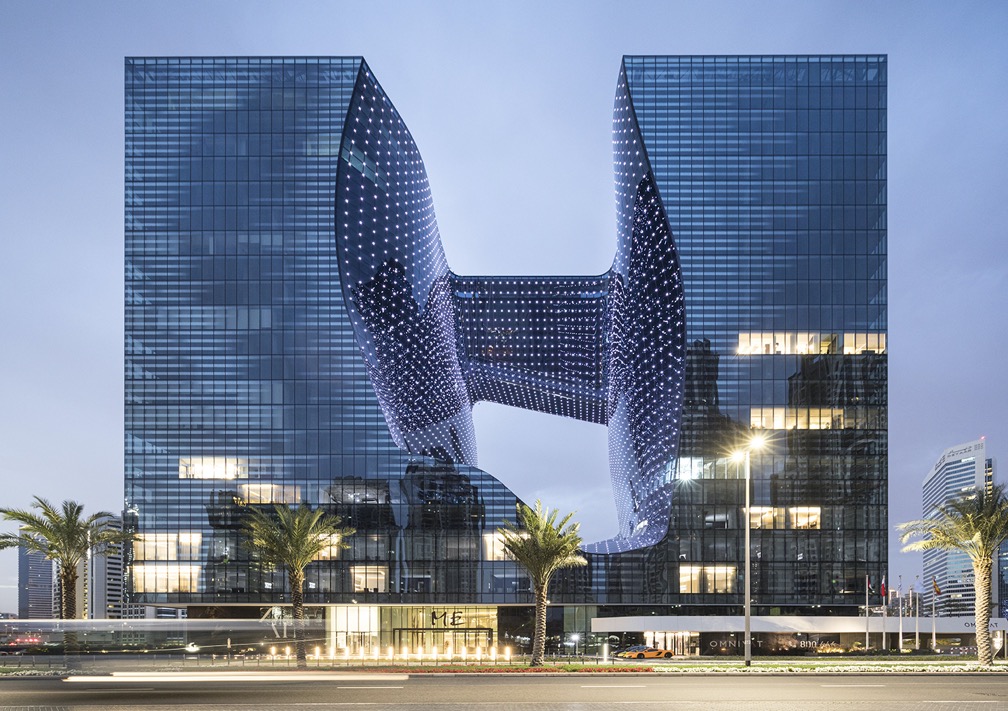
One issue was that the shaping of the inner void could focus the suns rays on to another part of the void, causing heat damage. So the shaping of the void was not just a decorative choice. In addition, another critical issue was picking the right type of reflective glass with a mirror frit that diffuses the reflected light and means that the surface colour changes during the day.
Not everything in Dubai architecture is about the biggest, tallest, mostest,… Let's take a quick look at Foster+Partners design for the Apple Store in The Mall. Firstly, its position is perfect, since it has a great view of the Burj Khalifa and a dominant view over the Dubai Fountains. Personally I think the terrace is probably the best place to see the evening fountain displays. Secondly, despite Foster+Partners claiming that it is an 'inspirational civic space', it looks just like any big modern shop designed to overpower customers with expensive materials and lots of glass. However, what is innovative are the automated 'solar wings' that are a re-interpretation of the traditional Arabic Mashrabiya, a way to give shade and protection from the hot summer sun, while allowing the cool air from the narrow streets to flow through. So the 'wings' shut when the sun is out, and open for the cooler evenings. Naturally, not content with a useful sun shade, Foster+Partners tells us that the 'solar wings' are a piece of 'kinetic art' and a theatrical experience inspired by a falcon spreading its wings. And just to cap the whole 'experience' the nine large planters also rotate mechanical to ensure that the trees receive even sunlight. As many people have pointed out, 'brownie points' to Apple for keeping their logo presence to a minimum on the terrace.
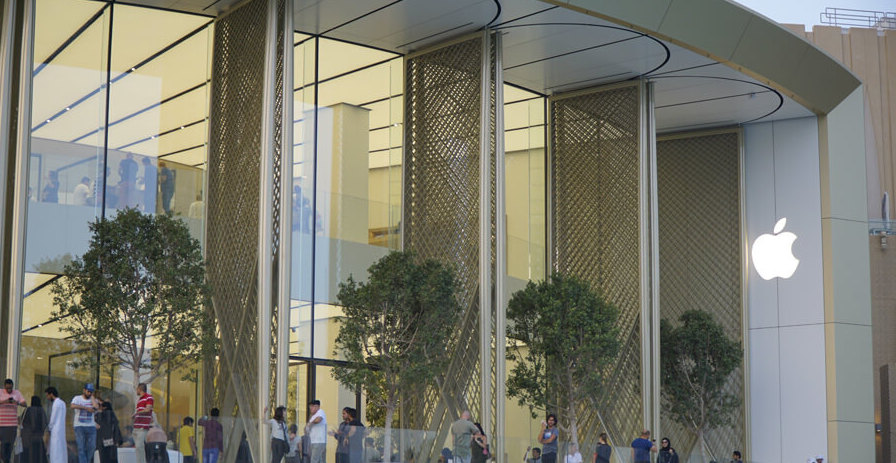
The amazing thing about Dubai is that it is littered with iconic architecture. The Dubai Frame actually won a competition to find an emblematic structure for Dubai. This is a structure you see when driving back and forth from the airport to the city.
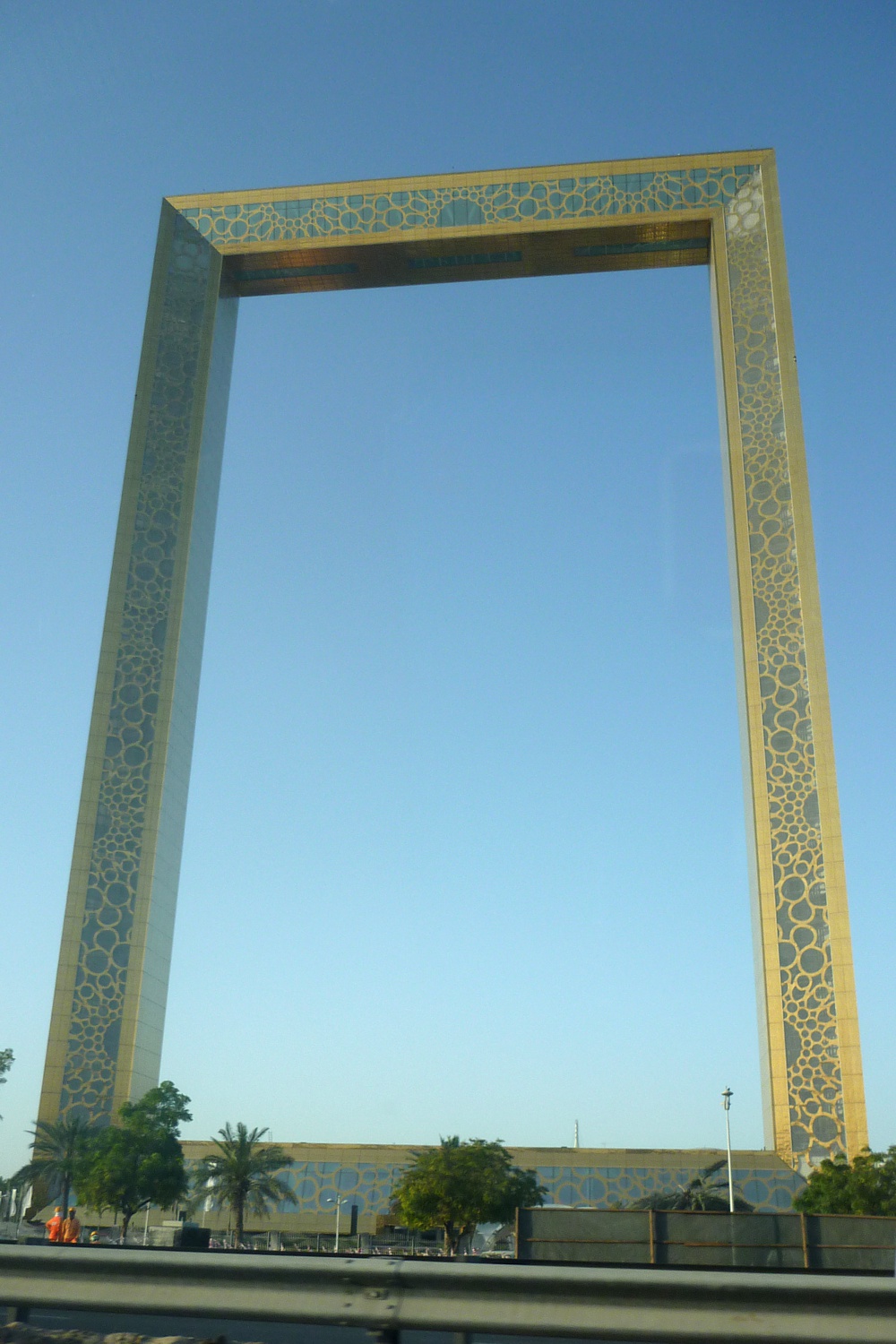

As you might have guessed this building is a picture-frame-shaped building 150-metres high, and with a 105-metre span. The building is covered with 1,200 square metres of yellow and gold photovoltaic glass on the façade, generating 38 kW.
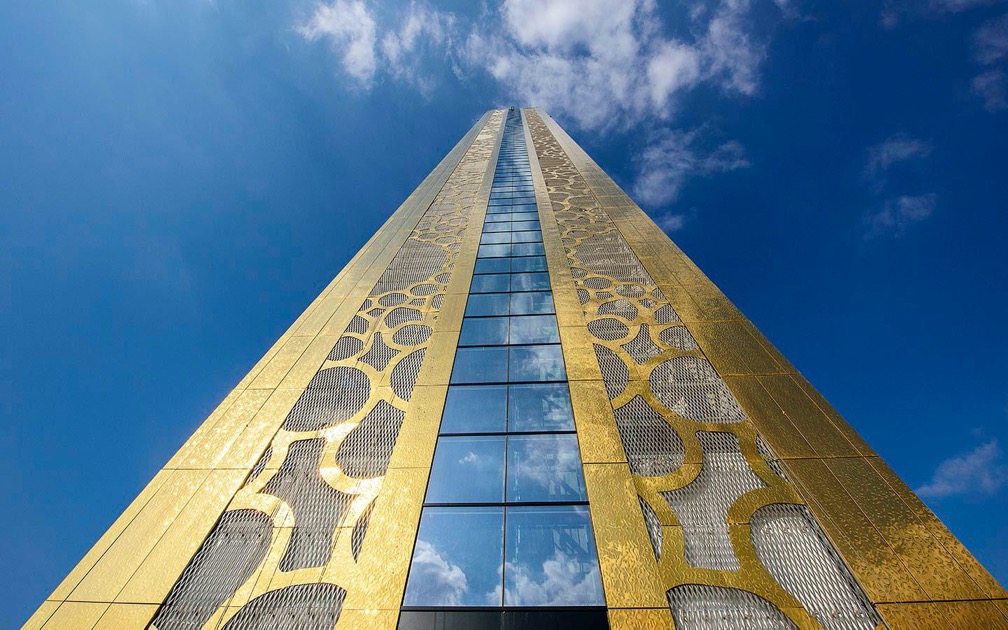
You can visit the viewing platform, and there is even a glass floor installed for those who enjoy a bit of excitement.
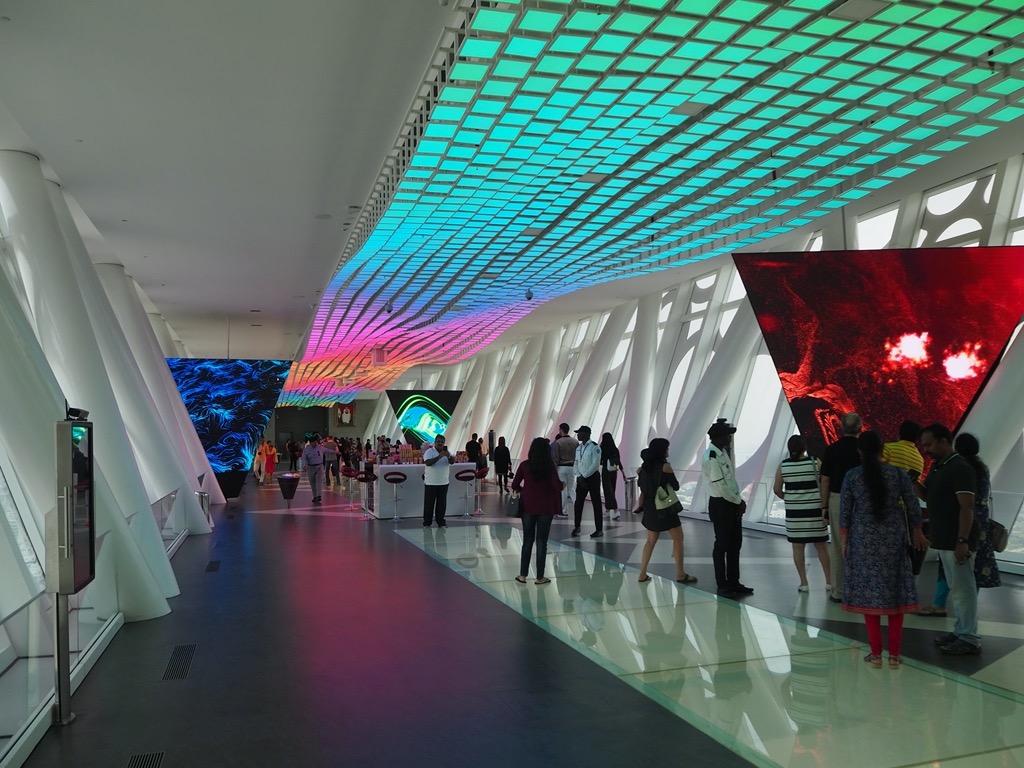

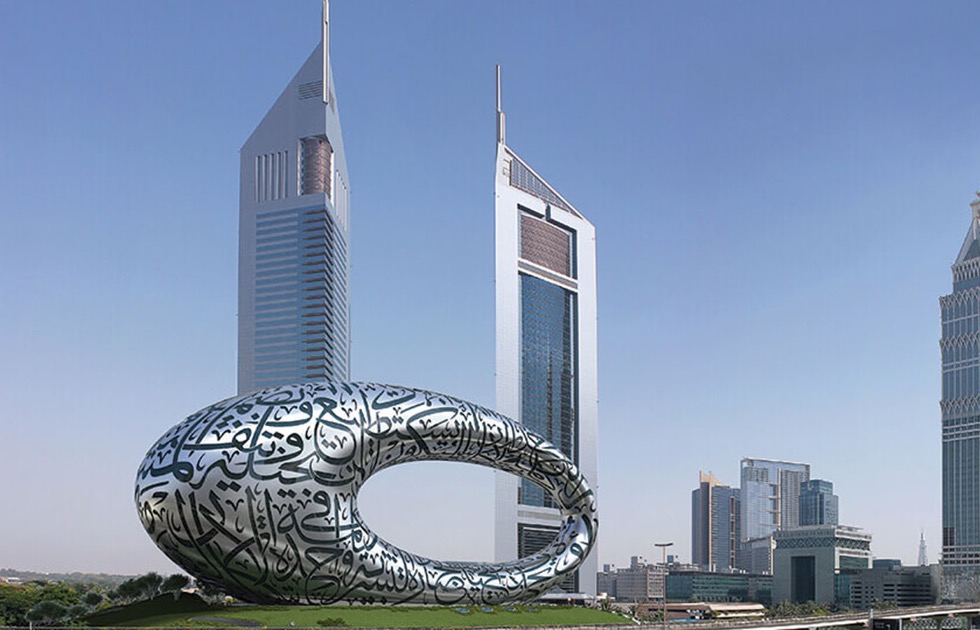
We can continue to visit iconic buildings in Dubai, but on this webpage we will stop with the totally unique 78-metre high Museum of the Future. The idea expressed on the museum website is to focus on so-called 'immersive experiences'. The basic shape of the building is a torus made up of 2,400 diagonal intersecting steel units, over which a façade has been attached.

The façade is made up of 1,024 panels which reveal a poem written in Arabic calligraphy.
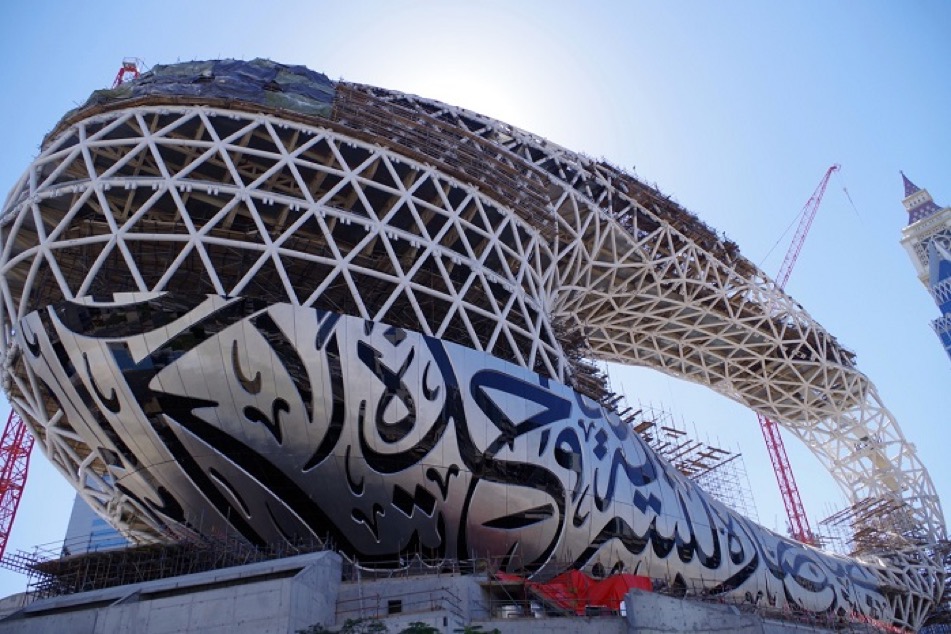
The cursive script doubles as the windows of the museum. The panels themselves are stainless steel finished fibreglass panels, and each is a different shape, as are all the windows.
